#they don’t represent the vast majority of viewers
Explore tagged Tumblr posts
Text
love getting my parents to watch my hyperfixations so i can get the opinions of the general audience with a single phone call
the general audience is pleasantly surprised by buck being bi, but dislikes telestrations due to the lack of shown redemption and general shittiness and believes for these reasons that he is not being written to last more than an episode or 2 into s8
slowly easing them into the concept of buddie so i can get the read on the silly little ship that has now fully consumed my soul
#911 abc#buddie#anti bucktommy#anti tommy kinard#anti lou ferrigno jr#i feel like we get caught up in fandom drama#and forget that temu’s stans may be vocal but their numbers aren’t large#they don’t represent the vast majority of viewers
30 notes
·
View notes
Text
Lets talk about Appendix #7
I won't be the first (nor the last) to admit that I’ve only ever paid super close attention to the Russia scenes during my major s4 rewatches (like 4x total). Those just don’t tend to be the scenes I rewatch looking for Easter eggs as regularly as I do with others. Though, I can say confidently now that this will not be the case anymore.
As I’ve said recently, the scenes that come off as unnecessary filler, are likely the ones hiding something deeper underneath the surface. Otherwise, why put any time into scenes that have no importance, beyond just to fill the running time? Especially in s4 when the episodes were really long and they could have easily cut out scenes if they weren't that important to the overall plot.
The reason they do this is because they can rest comfortably knowing that a vast majority of the audience will overlook these scenes, even call them pointless and boring (and they can laugh knowing they couldn't be more wrong). A vast majority of fans felt that way about the Russia plot, but even the Cali plot had a decent amount of viewers saying they were worthless all season with no importance to the overall story. And we all know that wasn’t actually the case. And so why would that be any different for the Russia plot?
And this scene right here, which I completely forgot existed (so pardon me if someone has talked about this before, because I've never seen any discourse on it), I only just remembered existed because of the Piggyback script dropping for the Emmy's.
I just want to preface that I'm being so so serious right now when I say this scene is very incriminating for Mike. Even down to the way it ends. It’s bad.
And by bad I mean holy shit they are sick for potentially hiding the truth in plain sight.
For context, in this scene, Yuri represents Mike & let’s say Dmitri represents the skeptical majority, who have been confused by Mike’s behavior for the last two seasons.

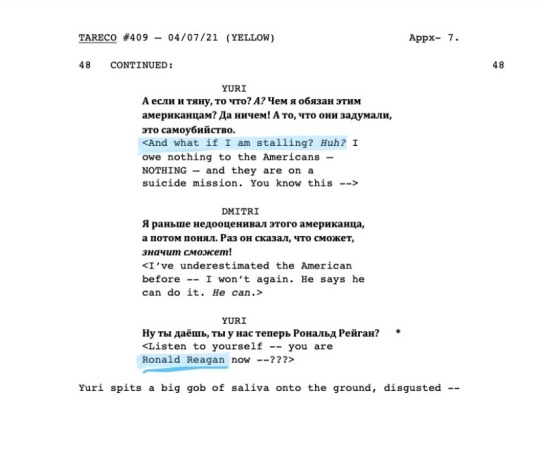


A lot to unpack here.
But first I want to give a disclaimer that Yuri is not literally Mike, nor are ALL of Yuri’s scenes meant to be about Mike.
It just so happens that Mike has a unique trend of his POV being missing from the overarching narrative. And how they play with that sometimes, is by strategically displaying his POV through other characters.
You might think I'm crazy, but this has happened quite a bit. The most well recognized example of this would be with Hopper at the end of s3 with the letter.
A less well known example would be with Argyle in s4. Again not all the time, but there are a couple specific moments that come to mind, where it feels like they are hinting at Mike’s inner feelings, by having Argyle display things Mike cannot express to the audience yet.
I always thought it was weird they decided to put Mike and Argyle in almost identical hats in the airport scene. Though, it makes a lot more sense when you see Argyle call him a shitty knock off, only to watch the whole group walking through the airport, with Mike to the left of El and Argyle to the left of Will.
Mike may be standing beside El with them looking like a happy couple, but he’s actually distracted and hyperfocused on Will. And so how they reference that, is by placing Argyle standing close beside Will, sort of mirroring the blocking of Mike and El. In Argyle’s case, he is not putting on a fake smile, instead he looks almost emotionless about what's unfolding. The blocking there definitely feels intentional, as it could be the writers way of showing us where Mike's head is truly at, aka focused on Will.
The other major example I can think of (there's not too many from what I've seen, but these two definitely stand out) is at the end of s4 when the boys arrive at Nina to rescue El. We've talked about how the explosion behind Mike as he was looking between El and Will, is representative of the extreme mix of emotions he is feeling at that moment. But no one has ever talked about Argyle's reaction in that scene. Knowing what the explosion represents, I think we should consider what Argyle’s reaction to the explosion itself might represent as well.
First, Argyle interferes with the Milkvan reunion, standing in the frame behind Mike, with his hands on his head looking at the fire blazing with stress.
But it gets even more dramatic than that, when El and Will are hugging, that's when Argyle really starts freaking out, OH SHIT AW SHIT, pacing back and forth.
By doing stuff like this, they can hide hidden meanings. It also just makes it a whole lot easier to come up with ideas for scenes. Because when they have a big component that is underneath the surface, they can build anything around that, as opposed to coming up with a bunch of ideas fresh on the spot, without any reason for it.
Which is why, tbh whenever I hear someone say it's not that deep, when referring to basic filming techniques of playing with POV, I'm just sitting there thinking, do these people not know how much easier it is for artists, when it is that deep? It’s sooo much easier (and gratifying).
But back to this scene with Yuri and Dmitri.
Yuri seems to be doing a lot also while doing very little reminds me a lot of Mike's method of boyfriendism at the start of 4x02. He brings El flowers, he's got a whole inspired Cali fit, he's feening happiness the whole time, holding her hand and skating together. He's basically giving off this vibe that he's going above and beyond, when really, we know that despite all those little things, he's not doing the one thing El wants him to do, which is to say I love you.
This scene in the piggyback script initially stood out to me because of the word stalling. And this is because whenever I talk about Mike’s behavior in s3, but especially in s4, with him repeatedly putting off saying I love you to El numerous timed, I often use the word stalling to describe it.
In his letters, he avoids it. In the flowers, he avoids it on the note. When she confronts him during their fight, he deflects, and makes a point to struggle using the word care instead. Even when she's literally crying he still can't muster it. When she's getting taken by the cops, he still doesn't think to say it, even now when things are so bad and it might have given her at least some comfort. When they're separated Mike, gets reassurance from Will that he can just say it to her when they reunite, though Mike doesn't look too excited about saying it. Then not even a day later (during the Letter to Willy scene), Mike tells Will he didn't know what to say to El, even though we all know it only would have only required those 3 famous words... And then him and El are reuniting and he still doesn't say it. And then they're in surfer boy and they get interrupted, but tbh the lead up to it felt super disingenuous anyways, with him looking like he was about to say something out of obligation and not because he wanted to say it. And then the literal moment that she is choking, he stalls, until Will encourages him, and then even still then, they make a point to put dramatic beat right before, and only THEN is that when Mike finally says it.! (And all of that isn’t even including the stalling he does in s3).
Basically, Mike is the king of stalling, but especially in s4 and the Piggyback specifically, bc stalling is what has led to this grand moment of Mike quite literally having no option to stall anymore.
And so stalling being used in this conversation with Yuri and Dmitri instantly peaked my interest. I barely remembered the scene from the show and yet the instant I did, I just knew what was about to go down was something related to Mike, that we wouldn't otherwise get insight on bc we don't have his POV right now.
In contrast to the episode, the script has Yuri admitting to stalling. He doesn't seem to have remorse about it at first, he actually seems kind of like he's willing to admit it because it's the truth. Then we get a Ronald Reagan mention from Yuri, followed by him spitting with disgust, which was not included in the final cut... still sort of an off moment, considering the very few Reagan mentions we've gotten in the series, it's been through the presidential campaign sign in front of the Wheeler's house in s2 most.
But now, this is where it starts to get a little scary in terms of what Mike could be thinking. I don't know how I feel about it because it's a scary concept.
You saw it with your own eyes. You know it to be true. And yet you continue to play tricks.
This could mean one of two things, or maybe even a mix of both...
It could mean that Mike knows El doesn't need him despite her begging for him to say the words I love you (he saw it with his own eyes?), but he isn't willing to accept it. He knows his feelings deep down will never change (he doesn’t love El), making his and El's separation inevitable (also reminds me of the suicide mission comment from Yuri...). He is fixated on this idea of her needing him and if not, losing her all together, instead of what El was actually upset about, which was not being loved.
Or it could (also) mean Mike understood Will in the van. He saw it with his own eyes aka the painting, he knew it was apparently for a girl Will liked, but it ended up actually being for him. And he seemed very happy about this as a revelation, up until Will mentioned it was actually from El. Not only that, but what followed was Will monologuing about feelings that matched closer to what Mike and Will had went through over the past year, not him and El. And so Mike realizes in this moment that Will does return his feelings for him, but he isn't willing to confront it aka he chooses to play tricks instead. He saw Will crying, yet he didn't confront it nor comfort him, and I think it’s at the very least bc Will crying that hard would have definitely caused Mike to start crying himself.
I also want to add that I think supports this sort of unraveling of Mike having different assumptions about the painting at different times. Because it appears in the hospital scene with Max, based on the blocking of Will, Mike, and El according to the painting on the wall in the background, that before this moment, he may very well have assumed the painting was from Will. But upon finding out El saving Max was a miracle, the painting shifts and is suddenly behind El.
I think that’s the main issue with deciding definitely one way or another how Mike interprets what’s going down. Because arguably, his feelings about the situation could actually be evolving based on the events around him unfolding.
Now let’s move on to the Peanut Butter Smuggler line. They use this to sort of make a reference to a past version of Yuri who was revered, and irrefutably considered a hero by many’ aka the mainstream ‘I miss s1-2 Mike Wheeler’ core.
And last but definitely, almost certainly not least, they show us Yuri reaching in his coat's inner chest pocket, to pull out the reason for the issue that was causing the stalling…
And that in the context of lettergate and even pocketgate, is pretty insane.
I also noticed a lot of scenes end with 'as...' in the scripts, as it's sort of their way to emulate the smooth transitions between scenes in words. While the scene directly after this is of Max and Lucas, the scene directly after that is Mike and El in Surfer Boy, right before they eat the pineapple pizza.
'Uncertain as...' Uncertain as who?!?!?! Max uncertain about the plan she herself insisted they do? Perhaps. Or what about Mike who is very much uncertain in all of his stalling glory, not even two scenes later, after they literally just acknowledged Yuri's stalling…
A lot of the pieces are there for this to play out, so I don't really think it's a reach anymore when you really start to add it all up.
Letter to Willy is a major proof that this is important. Although Mike ‘We’ve had it this whole time’ Wheeler was referring to a pen in that moment, the pen also came from secret hero agent man’s pocket, with the number (answer) being hidden inside, and with Mike’s shirt being off in that scene, though still in the frame in the right corner.
And then there’s the whole transition from Mike in Hawkins to the mailmain in Lenora in 4x01, DONT you worry Mrs Byers, it’s coming!!
If you want to know what I think personally. I don't know....
I do feel like what would make it super easy for everyone to figure out what's going on with Mike, is for us to finally read a letter from him, and with it ending with love Mike... Like it would just be that easy. Literally all of the contents could even be written off as a friend missing his friend platonically and really struggling bc he can't reach him, with him opening up about things that we already suspected, but that he hasn't said out loud. And then by simply ending it with love Mike, the case would be closed.
It would also perhaps explain Mike's inablity to write love to El in their letters. You’d think there had to have been something that made him overthink not doing that in the first place? And arguably, him having done it for Will when he tried to write a letter(s) to him, only to end it with love, followed by panicking and making the choice to never write Will a letter and instead focus on sending them to El (bc she’s his gf) it sort of starts to add up.
I also think I have a theory for when this letter will come into play in s5.
In the flashback of Suzie getting her computer taken by her dad, the last shot is of her night stand, which has a letter from Dustin, with a watch laying on top of it, also accompanied by an alarm clock that reads 5:02… I think it’s possible we could get lettergate being addressed as early as the second episode of s5. And with all the time/clock imagery surrounding it, there’s a good chance the cliffhanger of that episode could send us straight to the time jump…
Just a theory for now based on a lot of piling evidence. But it’s all very incriminating for Mike…
128 notes
·
View notes
Note
Hey different anon here. I want to get some clarification on your opinions re: the sukugo proshipping discourse. I don’t understand your position 100% and I think there are some oversimplifications, but this message is not meant to attack you at all. Like I agree with you on some things, and hope I can change your mind on some things or just have a conversation.
Like take for an example the fanart that you recently reblogged from flavoredmagpie. How does one categorize what “form” Sukuna is being depicted in that art? He has 2 arms, no mask on his face, so those factors put him closer to Yuji!Sukuna than True!Sukuna, if we HAVE to classify him as one or the other. His face looks older than Yuji, but so does Yujikuna sometimes (as in S2E17, where Yujikuna’s face and neck proportions are visibly different from how Yuji was previously depicted). And that fanart version of Satoru, if we have to categorize it, resembles Hidden Inventory Satoru more than 2018!Satoru, because of the hair and glasses and because the fanartist has also drawn this Satoru with Toji.
But I wouldn’t describe that fanart as “problematic” or proship. It seems pretty sweet and wholesome to me. And I think that’s because everything about the fanart makes it pretty clear the artist’s intention is to depict something sweet and wholesome. The character design isn’t supposed to evoke Yuji in anyway. So all the truekuna vs. yujikuna calculus in the above para. is kind of pointless, in the sense that it doesn’t really accurately account for the core essence of what that fanart is actually about, and it isn’t very helpful to viewers who are trying to make a moral determination.
Someone can say, “well the Sukuna form distinctions don’t really matter here because it’s clearly an au, and the canon characteristics aren’t applicable.” But that can be said of almost any fanart. I’d say the vast majority of fan content does not intend to depict canon versions of characters. I mean, that’s the assumption we have to make in order to say that sukugo with true!Sukuna is “morally acceptable,” because Sukuna’s true form incarnation is the recent chapters is still using Megumi’s body and still contains his soul, even if it looks nothing like Megumi. Therefore, every sukugo fanwork depicting true!Sukuna must be an AU or non-canon depiction in order to be unproblematic, because the True!Sukuna has to be the non-incarnated, OG OG version.
But if that’s the case, then you can say the same for most fanworks depicting Yujikuna and Meguna, that is, this is a non-canon depiction, or an AU, and the choice to depict these forms is simply a preference for a specific character design, e.g., the fanartist prefers to draw a version of Sukuna that is shorter than Gojo, or thinks he looks cooler in his Goth color variant (Meguna). And I think that IS what most fanartists drawing non-true form Sukunas intend.
To say, “depicting these specific visual designs of these two characters together is bad,” is a discredit to fan creators’ originality and inventiveness, and relies on a very narrow idea of the different ways creators can riff off of other creators’ works.
I also bring this up to avoid playing into sukugo-antis’ “this is a proship” claim because it is totally nonsensical. I agree with you, Sukugo is not a proship, because that’s a completely meaningless classification. Fans can depict any pairing in a problematic way — there are stsg/sgsts who depict that pairing as a toxic and abusive relationship, but it doesn’t make sense to say, “because of that, stsg is a proship.” If the underlying moral argument is, “fan creators shouldn’t encourage or romanticize harmful dynamics in their interpretations of pairings,” then we should consider each work specifically for how it represents and deviates from canon, whether there are elements of realism that make it sensible to apply certain real-world analogs or if it is fantastical enough that they are irrelevant (example: the sukugo 28 vs 1000 year old age gap — [1] this is not possible in reality, so one’s getting mislead recreating this in real life lol, and [2] there is nothing in how Gege or fanartists have depicted these characters’ dynamic to suggest their relationship is at all meant to model or analogize to a psychologically realistic relationship in reality.), what is the artist’s purpose for portraying this dynamic (supportive/critical/neutral/etc.), does their intent match what the work is actually portryaing, among other specific factors. This isn’t a process that makes for fast and clear distinctions, but preemptively saying “any work depicting a certain pairing is harmful/safe because that pairing is a proship/non-proship” is just a cheap and bullshit shortcut for actually thinking critically about what the pairing is and what fanworks are actually portraying. It is also a framework that enables fans to falsify moral arguments against pairings they dislike simply for personal reasons, which is what sukugo-antis are trying to do with skg.
I understand your point pretty well! I just think that it's a complicated situation because some people are actually proshippers (mostly on twitter from what I've seen) and they like the idea of Megumi or Yuuji (and even Yuta) being involved in sukugo stuff, which is weird to me because they're kids and I don't think they should be involved in that.. it's a kinda complicated situation that needs a lot to look into and analyze because there are good and bad apples in a fandom and it's hard to figure out which is which 😭
I prefer Sukuna being in his true form to be shipped with Gojo, so whenever I see art of Gojo kissing Meguna it makes me uncomfy because while I do understand that Sukuna is the one in control, it still doesn't take away the fact that it's Megumi's body and the notion comes off as icky. Though, I will admit that's not the case with ALL of the Meguna and Gojo art. I understand that some artists have a preference for character design too, but I don't think it's hard to draw true form Sukuna with black hair or just draw him shorter than Gojo but still true form. Though I do understand your point, I hope you understand my stance as well! I just think if we're given material of true form Sukuna it would be much more enjoyable to draw him as the way he was intended to be seen. Though, again, I understand that some people like Meguna's character design. I'm just glad we agreed on sukugo not being a proship because the definition does NOT fit them. Like, at all 😭
1 note
·
View note
Text
How it’d be to watch animes with them
A/N: While i’m working on my Mikasa x reader royal au, this little idea came to my mind. I tried to put the links when i mentioned a specific scene and speak a little about the anime in case you don’t know it. So here it’s:
Warnings: Me exposing my otaku self, mentions of 18+ animes (Not hentais)


Eren - Kaguya-sama wa Kokurasetai: Tensai-tachi no Renai Zunousen (13+)
A / N: The main characters like each other, but none wants to confess because being the person who takes the first step would also represent being the defeated person. The anime develops in a series of plans that both elaborate to make the other confess their love.
Warnings: None
It was his idea to watch an anime together since the two of you liked it a lot. You saw no harm and agreed to go to sleep with your boyfriend on Friday night. So, you would have the dawn and the weekend to see everything.
“We could watch One piece! Everybody likes"
“In three days ?! We will not finish even if we do not take breaks ”
"Naruto then?"
“Haven't you seen it all five times or more?
"But it is a classic!"
"It is also too long!"
He would sulk when he saw you reject each of his suggestions for being too big animes. The truth was, he was trying to convince you to stay longer. After much searching in the catalog, you choose to watch a short comedy of 12 episodes.
Biggest mistake ever
Eren is already annoying by nature, and after watching Kaguya-sama's two seasons he would spend the day and night trying to get you to confess to him EVEN IF YOU'VE BEEN IN LOVE FOR TWO YEARS AND HE HAS BEEN THE FIRST TO DECLARE. HIT HIM, PLEASE.
"Do you think that using such a low trick will make me give in?"
“Eren, I just got out of the shower. What trick? Wear an outfit? ”
“Showing off your skin won't make you win”
If you wanted to play with him, great. You are going to spend the day in this little game until he gets tired and just hugs you or something because he can't spend a lot of time without touching you. But if you didn't want to, just you could use that touchy side of him against him too.
"Maybe I shouldn't show you anything else then"
"Yes, of course, do- Wait what?"
"You heard"
“NO, BABE! YOU WON! I CONFESS! I LOVE YOU"
Watching anime with him would be quite an experience. For being very verbal, Eren would be the type of person who doesn't shut up watching anything. Especially, something that makes him laugh. You would see him laughing out loud and throwing himself back on the couch or on you, whether you were with him or not. You may even complain, but it would be fun to see him react to everything as immediately and naturally as an unfiltered child.
He will sing ALL the openings for the rest of the days around the house until you are humming some without realizing it.
For some reason, can I imagine him doing Chika dance ?? Yes, please film this big bear dancing like a little girl.

Levi - Death parade
A / N: Do you want to cry and hurt yourself? This is the right place. Death Parade is a story about what happens after death. The characters are sent to mysterious bars where they will be judged to decide the fate of the souls themselves. (18+)
Warnings: Suicide, depressive themes, mentions of rape and domestic violence
I don't see Levi watching many animes. In fact, I don't see him watching much anything at all. He would be the type of person who can't spend a lot of time in front of the television without feeling like he's wasting time. Which would result in a very selective and demanding taste.
He would always read the reviews about the film, and after watching it, he would make his own. Ever. No exceptions. Unlike Impossible-to-be-quiet-Eren, Levi would be silent to be able to capture and understand all the details. This is interesting because getting his attention is a difficult task. But once it's done, he is 100% focused on the story and immersed in the characters.
So, after reading about it, he would agree to watch Death Parade with you.
He would have low expectations at first, and if the anime failed to hold his very difficult attention in three episodes, he wouldn't even try with the rest.
So when in the first episode, all suspense and doubts left to the viewer entered Ackerman's head, he would finish the other 11 without realizing it.
As a rational person, he would love things that make him think and reflect on the proposed theme. In the case: Life and death.
For some reason, I imagine him as someone who would like to study and read philosophy as a hobby and that he would love Nietzsche? So, you could expect deep conversations after each episode.
But without any arrogance, humanity's strongest soldier might not be the most talkative man in humanity, but surely when he opened his mouth to it, it wouldn’t be to show himself off with something that he knows and you don’t. On the contrary, he would be more than happy to explain if you asked and added your opinion.
He wouldn't cry, but he would be touched by the way the emotions were shown and created in the characters.
He would probably see the scene where Decim cries more than once for being impressed with how the pain of a character who is supposedly not flesh and blood is expressed so well.
And after the anime is over, you would always see him listening to the music of the ice skating scene around the house while doing something.
When you were finished watching everything, you would talk again about the anime. You lying on his chest and he touching his hair, smelling him.
"Do you believe in reincarnation, Levi?"
“If so, I wouldn't go back to this shit a second time. No matter what they offered me ”
"Levi!"
"Unless it was to have you again"
“What a cliché” He would roll his eyes after hearing your response “But I like clichés”
Again, he wouldn't cry, but he would be thinking about how ephemeral things can be, including being alive. Then you can expect a more touchy Levi for a few days.

Jean - Banana Fish
N / A: Another one to cry and get hurt. Banana Fish is way more than just a story about one character just is hard to define. So in case, you didn’t watch it, here’s the trailer. (18+)
warnings: pedophilia, rape, violence, drugs, your heart being destroyed
You know that guy who says that no yaoi is good, it's just a way to feed a bunch of fujoshi and stuff like that? Jean. It's him. I just know it. So when you suggested Banana Fish and said it was a BL / yaoi, he would probably laugh and ignore the idea.
But after insisting a little and showing him the many compliments that both the anime and the manga received, he would accept.
At first, he wouldn't pay much attention. He really thought it would be just another bad anime. But by the end of the first episode, he would be too involved in the story to stop.
I think he would love crime novels for the same reason that Levi: To think. Try to find out how things are going to end and pick up any clues that the author has left about the ending. So the plot would hold him so much because he would make a ton of theories about the end.
He will ship Ash and Eiji with all his soul. I mean, how can he not ship? To see an anime in which the physical touch between the couple doesn't really happen and still builds a well-developed and healthy relationship would be a new experience for him.
Jean is somewhat similar to Eren in this respect. So you can expect to see him huffing in anger, cursing one of the characters, throwing a pillow away, or using it to hide a tear or two that he would let go of you. The kind of person who gets emotionally involved with the things he watches.
He would cry an entire river after watching the last episode and deny it later.
“I was not crying. The cushion fabric made my eyes itch a lot ”
Show him again and he will cry the same amount and intensity

Armin - Haikyuu
A / N: Considering all the texts on Tumblr for haikyuu characters, I’m pretty sure you know what anime it’s lol (10+)
Armin is an otaku with a license card and no one can change my mind. He would probably start watching it as a child. So, his first animes would be everyone's classics: Naruto, Dragon Ball Z, Bleach, etc.
So it would be normal that as the vast majority, he would continue to have a preference for shounen when he grew up. So it would be your idea to see Haikyuu.
He would have low expectations because he thought it would be just another anime with cute characters for everyone to be thirsty as an inverted harem. And also because the synopsis does not create a strong impression, especially for those who consume shounen daily.
"So we are just gonna see a little boy trying to catch a ball?"
“It's gonna be good! Everyone is talking about it now ”
"Does he have some superpower?"
"No"
"Something scary?"
"Armin, just give a chance!"
He would like it. Did I say he would like it? Because he would love it. The atmosphere created and well developed with such a simple plot would hold his attention well. (Is it possible to dislike Hinata in the first episode?)
It would be a great anime for him to watch because 1. It is different from what he usually sees. Unlike shounen, Haikyuu deals only with real and tangible scenarios. Of course, still with that touch of anime, but it is very easy to recognize yourself in the characters and learn from them and therefore reflect on yourself as well.
It would be great to make him think about his own insecurities and how most of them were inside his head.
He would be so immersed in the anime universe that he would have to pause the game scenes because he would be too nervous waiting for the ball to fall.
You will probably see him taking a deep breath in each drawing scene of the characters and see him truly cheering for the team as if it were a real national game.
More than that, you will see his eyes full of tears when Yamaguchi hit the serve in the match against Aoba johsai.
In fact, Yamaguchi would be his favorite character. No discussions.
"I said it would be good"
"Shut up"
"Make me"

Mikasa - Heaven’s official blessing
A / N: I'm going to leave the trailer here because I don't know how to define it very well. It's a novel, but the story doesn't focus ONLY on that. (14+)
Okay, you didn't suggest. She did not suggest. So how do you end up watching together? You catch her watching when you come home by surprise lol
Until then, you would know that she watched some anime, but nothing romantic. Never. In fact, that was her little secret.
Although common sense is that Mikasa would be cold even in a modern au (and I agree in parts). I think she would be the type of person who loves to see the sweetest and softest things to melt alone on the couch without anyone seeing. A moment for herself and a part of her that she would not show to anyone.
You would already know about her romantic side, but seeing her under the covers sighing while watching the Netflix special episode is a totally different story.
Please don’t mock her!!. She would be red enough by the time she was discovered.
When she was less shy, she would ask if you want to watch with her. She would say she saw no problem watching it with you again since doing it with you would be a different experience.
If you accept, you would spend the rest of the night in the room sharing a blanket and absorbing the soft atmosphere, the soundtrack, and the Chinese culture so present in history.
She would not speak a lot because she was paying attention, but she would hug you all the time. In the romantic scenes, she would tighten her arms around you a little and sometimes left a kiss on your shoulder.
I think she could relate to Hua Cheng's way of loving. He is always there to protect, care for and see his lover even if sometimes Xie Lian doesn't even know.
And that is what she wants to show you, that more than a girlfriend, she is also someone you can count on.
Days later, you will see her reading the rest of the work around the house because she couldn't stand to wait for a second season.
And later, SURELY melting and vibrating while watching Mo Dao Zu Shi.
#aot x reader#aot x you#eren x reader#mikasa x reader#armin x reader#levi x reader#jean x reader#kaguya sama wo kataritai#haikyuu!!#banana fish#death parade#heavens official blessing#shingeki no kyojin#shingeki no kyojin x reader#aot imagines#eren jaeger x reader#eren headcanons#mikasa headcanons#armin headcanons#levi headcanons#jean headcanons
256 notes
·
View notes
Text
Why I don't like traumacore: A sourced masterpost.
This is something I've been asked a few times, and often the argument used to support traumacore involves art therapy. I figured I'd make a full post explaining in detail why I believe traumacore is often harmful to both the creator/poster and to the viewer. This post will be long; I apologize, but I wanted to make everything as clear as I could. Sources are cited or linked throughout.
Trigger Warnings: Discussion of traumacore, the messages and imagery used within the traumacore genre. Self-harm is mentioned, and suicide is very briefly mentioned as well.
Traumacore is not art therapy, nor is it therapeutic as a whole.
The type of traditional art therapy that traumacore is most similar to would be collage art, which involves creating something through the collection of other images and quotes. However, a notable difference between traumacore and art therapy is that art therapy is undergone with a licensed psychologist; the art is created in order for the psychologist to talk with the patient, figure out the underlying emotions that the art represents, and then work with the patient on how to replace the harmful or negative emotions like shame, fear and disgust with more positive ones. Art therapy is designed to help the psychologist guide the patient towards acceptance of their trauma, which can then allow them to work on healing.
To quote this psychology today article, “No artistic talent is necessary for art therapy to succeed, because the therapeutic process is not about the artistic value of the work, but rather about finding associations between the creative choices made and a client's inner life.”
To go further back, Margaret Naumberg (regarded by many as the mother of modern-day art therapy), used the technique of art therapy to promote introspection in the client. A quote from one of her books, “Dynamically Oriented Art Therapy: Its Principles and Practices”: “Whether trained or untrained individuals have the capacity to project their inner conflicts into visual form. In this approach, the therapist withholds interpretation, encouraging clients to discover what their picture means to them”.
This is where my issues with traumacore as an aesthetic begin. The vast majority of the traumacore content is not based in the idea of creating the images so as to examine the underlying feelings or undergo self-examination; it’s vent art made purely to be posted and then left.This is not the same thing as art therapy, which is based on the principle that the art should be looked at and thought about by its creator and a therapist to uncover what lead to its creation.
Venting in this way may provide temporary relief, but does not contribute to healing in the long run – as this study on art therapy as a venting method in adolescents says, the art “allows both therapist and client to better address the problem”. In addition, studies have found that venting alone does not cause the emotional distress surrounding a big event (such as a traumatic experience) to go away or even diminish - the benefits can be useful, but are often only temporary. (Links One, Two).
It's also been found that venting can elicit strong emotional responses in the listener; depending on circumstances, hearing someone else vent about a negative event may produce negative feelings in yourself.
(TW for this paragraph: Discussion of traumacore, abuse mentioned, blood and gore mentioned) This is particularly true with traumacore: The messages displayed are often entirely based on the worst things that can happen to a person, and will also speak directly to the viewer. Messages like “It was all your fault”, “I ruined everything”, “I can’t take this any more”, or sometimes depictions of innocent-looking things (like toys) surrounded by blood, gore or distressing wording are naturally going to cause people with trauma based in those things to be triggered. The language used can often mirror that used by abuser(s); of course that would be triggering to someone who has suffered abuse and trauma.
I myself write poetry about the worst things that have happened to me, and I then discuss these with my therapist. If I were to post it, it would be upsetting and triggering and distressing by nature, because of the very content of the art form. The same applies to traumacore.
There’s also the issue of how traumacore is often paranoia- or delusion-inducing in those with psychosis. Even traumacore that is not created by people with psychosis will display psychosis-triggering imagery or wording. Examples of this is linked here: (Trigger Warning: this links to a post with traumacore that contains religious imagery, delusional thinking and potential paranoia-inducing content as an example.)
This isn’t something that can be excused by trauma, venting, ""art therapy"" or anything else. It’s just ableist. It’s actively damaging to trauma survivors as a whole, and especially to psychotics (such as myself) – whether they are trauma survivors or not. There is no excuse for it.
To summarize:
Traumacore, on the face of it, may come across as a weird-but-useful coping mechanism taking inspiration from the psychological technique of art therapy. The reality, however, is that traumacore is not art therapy at all; it is inherently vent-related in nature with no focus on introspection, and as a result can be incredibly damaging. Traumacore often focuses on the messages of the abuser, or on the shame related to having trauma, which – rather than removing power from these – actually reinforces those negative messages through the nature of repitition, and therefore the negative experiences and emotions surrounding those messages. Even going off personal experience alone, I myself along with a number of other trauma survivors I have spoken to have had all sorts of awful reactions to seeing traumacore, including flashbacks, panic attacks, sudden suicidality, and psychotic episodes.
Now, does this mean all trauma- or vent-based art is harmful? No. Lots of art can be created out of negative experiences – as mentioned above, I myself write poetry.
Does it mean that the traumacore, whilst a potential temporary coping mechanism for some trauma survivors, can be incredibly triggering, destructive and distressing to those with trauma and/or psychosis? Yes.
If you want to vent your trauma, there are healthier and better ways of doing so than traumacore. I would say that it’s a coping mechanism in the same way that physical self-harm is a coping mechanism; just because it provides temporary relief does not make it healthy, good or worth promoting under any circumstances.
If you want to take a closer/more in-depth look at actual art therapy, my personal favourite book on the subject is "The Art and Science of Evaluation in the Arts Therapies: How do you know what's working?" by Elaine and Bernard Feder. It goes into what the basic principles of art therapy are, and how art therapy can be used most effectively. In my opinion it's also written in a way that's easier to understand than some of the heavier psychology books.
#traumacore#traumacore tw#ok to rb#masterpost#sources#important#(tagging important so I can find it later lol)#self harm mention tw#self harm ment tw#suicide mention tw#trauma tw#abuse mention tw#gore mention#gore ment tw#ventcore#ventcore tw#ventcore and traumacore are VERY heavily intertwined so im tagging for both
194 notes
·
View notes
Text
The Queer Appeal of Sk8
Recently @mulberrymelancholy reblogged a post of mine with a truly galaxy brain take about how Sk8 “is a show made for queer fans” and generally how sports anime often depicts love and relationships in a way that’s more accessible and relatable to ace/arospec people than other mainstream media does.
Just, *chef’s kiss* fucking brilliant. I urge you to read their post here (note I’m referring to the reblog not the actual post).
And basically, it got me thinking about this concept of Sk8 as a Queer Show, and the kinds of stories and dynamics that tend to attract queer audiences in droves, regardless of whether its queerness is made explicit or hell, whether that queerness was intended.
And that’s what I’ve been pondering: What are the cues, markers, or coding, in Sk8 that set off the community’s collective gaydar?
I obviously can’t speak for the community. So here’s what aspects of the show intrigued me and what, for me, marks Sk8 as a Queer Show beyond the subtextual queer romances: a punk/alternative aesthetic, Found Family, Shadow as a drag persona, and The Hands.
1.) The Punk Aesthetic
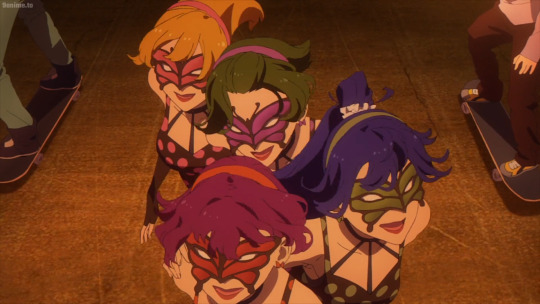
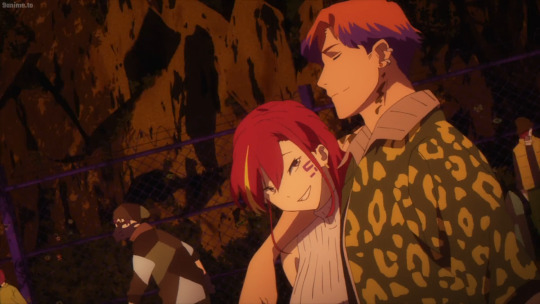

All three of the above screenshots are taken from Ep 1, and every single one of them depicts background characters. They’re nameless and ultimately unimportant characters, yet each of them designed so distinctly and so unique from one another, one could mistake each of them for the main character(s) of another story.
Of what little I know about Punk subculture, I do know this: that the ethos of Punk is heavily built around a celebration of individuality and non-conformity. Sk8 seems to have incorporated this ethos into the very fabric its worldbuilding, and the aesthetics and culture upon which it takes inspiration appeals specifically to a queer audience.
I don’t really need to explain why Punk has such deep ties with the queer community. For decades, queer people have found community and acceptance within punk spaces, and punk ideology is something that I think is just ingrained in the queer consciousness as both lived experience and a survival tactic.
Therefore, a show that adopts punk aesthetics is, by association, already paying homage to Queer culture, intentional or not.
Queer fans notice this- like recognizes like.
2.) Found Family
This also needs little explanation.
Too often, queer individuals cannot rely on their “born into” families for support and acceptance. Too often, we are abused, neglected, and abandoned by those who we were taught would “always be there for us.”
And so, a universal experience for queer people has been redefining the meaning of Family, having to build our families from scratch, finding brothers, sisters, mothers, and fathers in people with whom we have no blood relation, and forming communities tied together by shared lived experience rather than shared genetics.
And this idea of Found Family is also built into Sk8′s narrative.
Like, for example, the way that Reki promises MIYA that he and Langa will “never disappear from [his] sight,” filling the void that MIYA felt after his friends abandoned him.
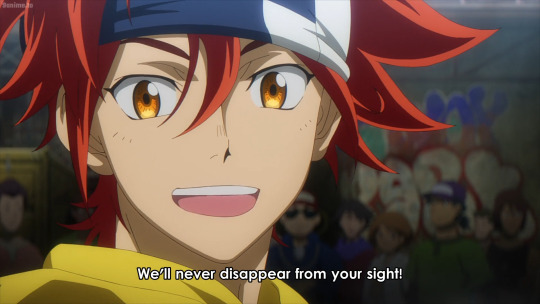
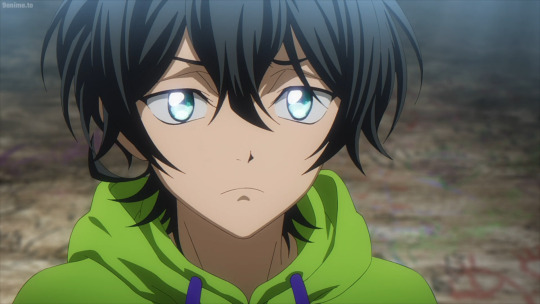
And in the way that JOE becomes a paternal figure for Reki, teaching him ways to improve in skateboarding, and ensuring that Reki doesn’t self isolate when he’s feeling insecure.
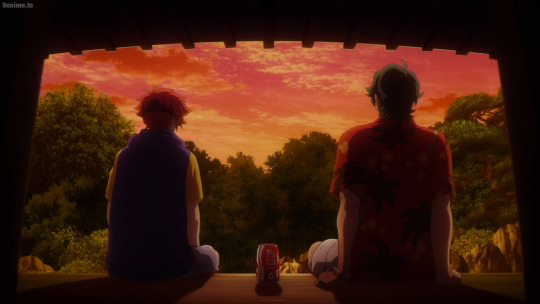
And in the whole Ep 6 business with Hiromi acting as babysitter to the Gang.
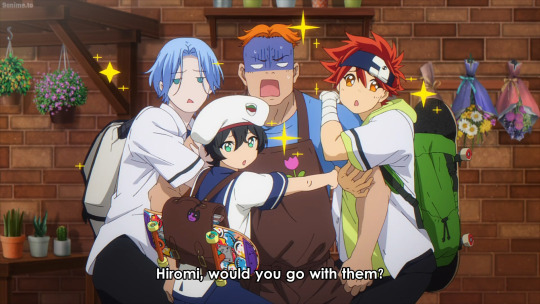
Hell, even ADAM (derogatory) is associated with this trope. Abused as a child, he finds solace in an underground skateboarding community and culture he helped create- his own found family (or some powertrippy version of it anyway).
Again, queer fans see themselves depicted in the show, but this time in the way that the show gives importance to Found Family relationships between its characters.
3.) Shadow and Drag
This is one that’s more of an association that I personally made. But I was intrigued by the way that Hiromi adopts his SHADOW persona. He wears SHADOW like a mask, and adopts a personality seemingly so opposite to his day-to-day behavior.
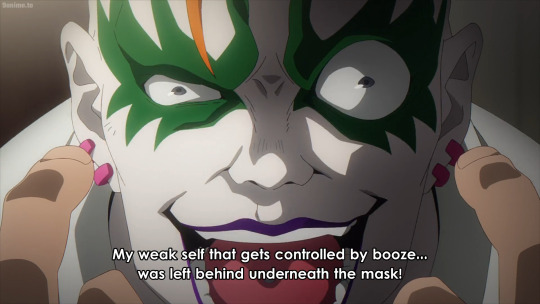
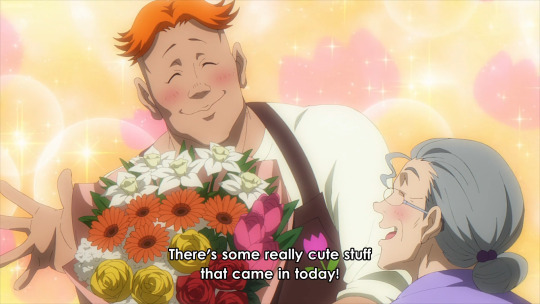
Further, the theatricality and general “gender fuckery” of his SHADOW persona, to me, just seemed so similar to a the characteristics of a drag persona (I don’t know a whole lot about drag but enough that I’m drawing superficial similarities).
There’s also this aspect of a “double life” that he, and actually all the other adult characters of the show, have to adopt, which is a way of living that I’m sure a lot of queer viewers see themselves reflected in.
4.) The Hands
Ohhhh the Hands.
One of the things I noticed very early on is the way the show constantly draws our attention to Reki’s hands, which I thought was a little strange for an anime about skating. After all, skating doesn’t really involve the hands, or at least the show doesn’t really draw attention to hands within the context of skating.
I count 3 times so far between Eps 1-9 in which hands are the focus of the frame.
First, when Reki teaches Langa how to fist pump after Langa lands his first ollie, second, when Reki and Langa make their Promise, and finally, when Langa saves Reki from falling off his board.
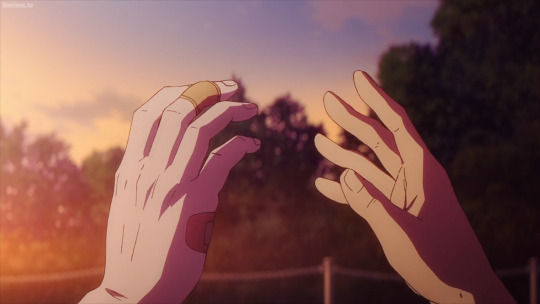
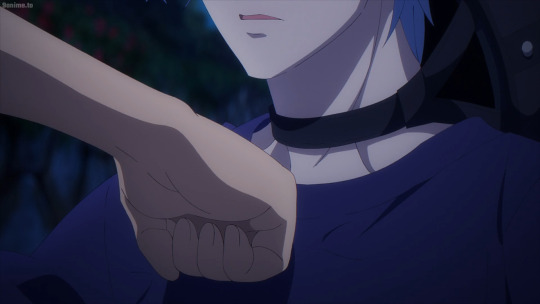

And you know what they say, twice is a coincidence but thrice is a motif (no one else actually says this I think I’m the only one who says this lol).
I’m not really certain why hands seem to be such a shared fixation among queer people (at least among those I interact with). All I know is that gay people are just fucking obsessed with them.
I have a Theory as to why, and at this point I’d love for other people to chime in and “compare notes” if you will, but I think it basically has to do with repression. And in the same way that queer people have had to redefine the meaning of family, we’ve also had to redefine intimacy.
Being overtly physically affectionate with someone of the same sex, even if they’re your significant other, or often specifically BECAUSE they’re your significant other, can still be dangerous, even now despite the “progression” of society. Queer people know this, this vigilant surveillance of our environment and ourselves, always asking ourselves, “Am I safe enough to be myself?”
Already, Western culture is pretty touch-averse. That is, it’s considered taboo to touch someone unless they’re a family member or a romantic partner. And to touch a person of the same sex in any way that could be misconstrued as romantic (which is most things tbh) is a big no no.
There’s just A Lot to unpack there.
But basically I think that queer people, by necessity, have had to learn to romanticize mundane or unconventional ways of being physically intimate so that we can continue to be romantic with one another without “being caught” so to speak.
Kissing and hugging is too obvious. But a handshake that lingers for just a second too long is much more likely to go unnoticed, braiding someone’s hair can easily be explained away as just lending a helping hand, touching palms to “compare hand sizes” is just good fun.
But for queer people, these brief and seemingly insignificant touches hold greater meaning, because it’s all we are allowed, and all we allow ourselves, to exchange with others.
God, I’ve gone off and rambled again. What’s my point? Basically that the way the show draws attention to Reki’s hands, and specifically how they’re so often framed with Langa’s hands, is one of the major reasons why I clocked Sk8 as a Queer. It’s just something that resonated with me and my own experience of queerness, and I know that I’m not the only one who noticed either.
~
So in conclusion, uhhhh yeah Sk8 the Infinity is just a super gay show, and it’s not even because of the homo-romantic subtext (that at this point is really just Text).
Because what’s important to understand is that Queerness isn’t just about same-sex romance.
Queer Love isn’t just shared between wives/girlfriends, husbands/boyfriends, and all their in-betweens. Queer Love can be two best friends who come out together, queer siblings who rely and support one another, a gay teacher who helps guide one of their questioning students, a queer community pitching in to help a struggling member.
And that all ties with another important thing to consider, that what we refer to as the “queer experience” or “queer culture” isn’t universal. In fact, it wrongly lumps together the unique experiences and struggles of queer BIPOC all under one umbrella that’s primary White and middle class.
So I think what drives a lot of my frustration about labeling a show like Sk8 as Queerbait is this very issue of considering queerness and queer representation within such narrow standards, and mandating that a show must pass a certain threshold of explicit queerness to be considered good representation.
I get that someone might only feel represented by an indisputable canonization of a same-sex couple. That’s fine. But labeling Sk8 as Queerbait for that reason alone ignores the vast array of other queer experiences.
The aspects of Sk8 that resonate most deeply with my own experiences of queerness is in the way that Reki and Langa share intimacy through skating (intricate rituals heyo). For me, them officially getting together ultimately doesn’t matter- I’ll consider Sk8 a Queer show regardless.
Similarly, @mulberrymelancholy finds ace/arospec representation in that very absence of an on-screen kiss. A bisexual man might find representation in Reki, not because he enters a canon relationship, but in the depiction of Reki’s coming of age, growing up and navigating adolescent relationships. A non-binary person might feel represented through CHERRY’s androgyny.
That’s the thing, I don’t know how this show will resonate with other members of the queer community, and it’d be wrong to make a judgement on Sk8′s queer representation based on my experiences alone.
That being said, Straight people definitely don’t get to judge Sk8 as Queerbait. Y’all can watch and enjoy the show, we WANT you to enjoy these kinds of shows, and we want you to share these shows and contribute to the normalization and celebration of these kinds of narratives.
But understand that you don’t have a right to tell us whether or not Sk8 has good or bad queer representation.
And even members of the queer community are on thin ice. Your experience of queerness is not universal. Listen to the other members of your community, and respect that what you might find lacking in this show may be the exact representation that someone else needs.
#and scene#i was up till 4am writing this instead of doing my hw#bc i hav Opinions dammit#sk8#sk8 the infinity#sk8 meta#sk8 theory#queerbait
292 notes
·
View notes
Text
Put On Your Raincoats | Suburban Dykes (Sundahl, 1990)

The vast majority of vintage pornography I've watched has been directed by straight men, for straight men, so it was interesting to see something geared explicitly toward lesbian women. Watching the results, I don't know if I detect a huge difference in terms of visual language (one key but fairly static shot is framed strategically to accentuate Nina Hartley's rear end; I suppose if you want your viewers to get off on physically attractive people having sex, there will be similarities in how you shoot them). But you do get perhaps a different set of archetypes, most notably the butch escort played by Sharon Mitchell, clad head to toe in an all black get-up, greaser style, towering over her co-stars. (Mitchell has always registered as "cool" in a way most pornstars haven't, so she's perfect casting here.) "Happy Gay Day, ladies," she announces.
There is a certain charge from having such a forceful, masculine presence enter a non-threatening domestic environment (think of all the home invasion movies you've seen, where a weak, often bespectacled hero is menaced by the more alpha, rough around the edges villain). That being said, any real sense of threat dissipates once Mitchell tells the protagonists about the importance of safe sex and proceeds to demonstrate such techniques. (It's always nice when someone practices what they preach.) This scene represents the climax of the movie, which is about two lovers played by Nina Hartley, who is always a welcome presence, and Pepper, who I'm not familiar with but is not an unpleasant presence either. The movie starts with the two of them in a hot tub, Hartley warning Pepper about "lesbian bed death syndrome" and recounting to her a sexual encounter between friends she happened to see (Pepper calls her a "Peeping Tammy"). The action then moves to the bedroom, where Pepper calls a phone sex line while Hartley listens in, which I assume is the early '90s equivalent of sharing your Netflix password. Finally they decide to call an escort service, and voila, enter Sharon Mitchell.
This is a seemingly low budget SOV production, so there is a certain flatness to how much of the movie looks, especially the climax shot in the heroines' living room (the excess of wood paneling does not provide much of an erotic charge). But you do get bits of stylization, like with the steely blue lighting and closer camera angles in the flashback, and the shadows and canted angles used to shoot the phone sex operator, who sounds like a more foul-mouthed Katharine Hepburn. (I followed this up with Clips from the same director and production company, which is more aggressively stylized, particularly in a ritualistic early segment that lays on the video colour effects thick. I'm definitely interested in exploring further into their body of work.) And the banter between Hartley and Pepper ("Don't let the lesbian bed death get you!") has a nice, unforced quality, and the eventual pillow fight that breaks out carrying a convincing degree of spontaneity. They're quite enjoyable to hang out with, which makes this a pretty easy thirty minutes to sit through.
2 notes
·
View notes
Text
Kang & The Cold War
I really enjoyed having Angela Kang at the helm for S9-S10. Kang is a gifted storyteller, and the Whisperers were the most intricately conceived villains that I’ve ever seen on screen. Alpha’s group represented a huge existential threat: they were incredibly powerful and could easily wipe out a community in the blink of an eye.
Does this capacity for instant annihilation remind you of anything?
It’s no accident that Michonne uses nuclear imagery when discussing the horde. Kang makes clever use of Cold War themes throughout the Whisperer plotline to underscore that TWD family are closer to midnight than ever before.
And if you don’t want to take my word for it, take Kang’s: “Thematically, we wanted to kind of talk about a war that felt like it had Cold War aspects and the Whisperers like always watching our people” (The Walking Dead season 10 kicks off in outer space: Here's why | Metro News).
Anyway, on to the Cold War parallels that I noticed and why Kang did such an exceptional job in S9-10.

“Oh, those Russians!” & The Doomsday Device
S10 starts with a U.S.S.R satellite falling from the sky. It’s a piece of Cold War technology which can be traced back to the Eastern bloc (which comprised of the Soviet Union and their satellite states). It’s worth noting that lots of countries have space infrastructure and hypothetically a falling satellite could have come from any nation. I’d wager that Kang opted to have the U.S.S.R initials visible on the satellite because these letters have very distinct Cold War connotations which will resonate with viewers. The satellite crashes to Earth and our heroes are forced to stray into Whisperer territory to control the blaze. Kang’s use of the fallen satellite ties the old pre-apocalyptic Cold War threat to the apocalyptic equivalent of a doomsday device (the horde).
Remember when Michonne reminds Aaron, “They (the Whisperers) have a nuclear weapon and we don’t!”
Well, TWD family have fought many enemies by the time S10 rolls around but I don’t ever recall nuclear imagery being used in relation to their opponents. And I think this is because the Whisperer threat operates differently from other villains. S3-4 and S6-8 essentially present bad apple scenarios – get rid of the Governor or Negan and most of the remaining Woodbury folk/former Saviors can peacefully co-exist with TWD family.
To me, it seems very significant that the Whisperer threat does not evaporate following Alpha’s death. Unlike with the Governor or Negan, a regime change is not enough to dismantle the Whisperer infrastructure. This mirrors the reality of Cold War politics: for instance, the Cold War long outlasted Stalin’s death in 1953. Even if you get rid of one figurehead, the nuclear infrastructure (or in TWD’s case, the horde) does not go away. The doomsday device is always a disaster waiting to happen.

The Spy Who Came In From the Cold
Covert operations are always important in warfare, but stealth technology really took off in the nuclear age. Cold War powers developed technology with decreased radar detection, meaning that they could fly covertly over enemy territory. The Whisperers have invented their own sort of natural stealth technology with their masks along with their ability to blend with the horde and cover vast distances undetected. The Whisperers are paradoxically a danger of enormous proportions and a threat that can remain largely invisible until the moment of impact – by the time you see them, it is already too late.
Fears around espionage and enemy infiltration were another major aspect in the Cold War. In TWD, we’re presented with infiltrators working on the inside to bring their opponents down: Dante is working for Alpha and Negan is secretly following Carol’s orders. Dante’s operations breed paranoia in Alexandria and emboldens the vitriolic members of the community to take action against Lydia. This dangerous misdirection of anger reminds me of the Second Red Scare/McCarthyism where individuals would be hounded due to their alleged communist sympathies – the vast majority of these targets had no connections whatsoever with communism, but it was politically expedient to bully them into submission. Just as it is seen as expedient for the small gang of Alexandrians to punish Lydia for the crimes of her people – she’s a far easier target than taking on the Whisperer army.

Two Tribes
I’d argue that the clashes with Woodbury and the Saviors were more about the oppressors versus the oppressed, rather than culture clashes. The same can’t be said for the Whisperers, who are completely alien to our protagonists in so many ways.
- Alpha’s group actively pursues an itinerant lifestyle whereas TWD family always try to put down permanent roots.
- The Whisperers presumably subsist on a meat-based diet given that they will not stay long enough in any location to grow crops. This might seem like quite a minor point, but I think it’s important because Kang’s era places a heavy visual focus on the agricultural boom in Hilltop and Alexandria – we’re given sweeping shots of crops and the Alexandria windmill is an iconic structure of the community rebuild in S9. I’m writing this without the benefit of a re-watch, but I don’t think (?) we see anyone in the Whisperer camp eating fruit, vegetables, or grains. We do see them consuming meat, Lydia eats a worm at Hilltop and there’s the hog roast courtesy of Negan. Two whisperers comment on the differences in food culture – Mary notes that Aaron has bread with him every day and the Whisperer taken captive is disdainful about Alexandria’s approach to food. According to Whisperer logic, Alexandria’s food culture forms part of the cosseted lifestyle championed by the permanent settlements.
- The Whisperers have a culture of corporal punishment. Alpha stoically accepts her lashes and Lydia’s scars suggest that this sort of physical abuse occurs on a regular basis. These practices are totally reprehensible to the settled communities.
- The Whisperers have a non-literary culture. Lydia struggles with reading in S10 and this is all the more interesting because Richonne cultivate Judith’s literary development in S9 (Rick reads The Wizard of Oz to her and Michonne reads Game Day to her). I think (?) this is the first time we’ve ever seen Judith being read to? Either way, S9/S10 establishes that literacy and formal learning are important to the Alexandria settlement, but they are seen as irrelevant by the Whisperers.
- And oh yeah, the big one! The Whisperers willingly surround themselves with the undead – the absolute antithesis of what our protagonists have been doing for the entirety of the show.
Kang’s careful story-telling constantly reminds us that the heroes and the Whisperers are diametrically opposed on so many fronts – akin to how the East and West were historically seen as total opposites. The differences between the Whisperers and the settled communities are irreconcilable. The mere existence of the settled communities is a huge problem for the Whisperers because Alpha has done her upmost to prove that these sorts of spaces can’t exist in an apocalyptic landscape. So long as the settled communities exist, there will always be the temptation for those like Mary and Lydia to choose another path. Alexandria poses an ideological threat to the Whisperers, just like the allure of the West posed an ideological threat to the Eastern bloc.

Red Alert – The Reapers do not track with Kang’s style at all
Ultimately, the point that I’m trying to make is that Kang can write excellent villains and she weaves her story threads incredibly carefully. And I think this is why the Reapers felt so off kilter to many of us.
Wiser heads have already highlighted that S11 shows many signs of interference and I think you can really tell that the Reapers have been co-opted because we’re given practically nothing to work with. I mean, we get some locusts and . . . Oh no wait, that’s basically all I remember. It just doesn’t track given Kang’s level of attentiveness and attention to thematic motifs with the Whisperers.
I don’t think that it’s a natural progression to go from writing the most intricately thought out and complex threat to something as unremarkable as The Reapers. To me, the Reapers have more in common with the villains penned by other showrunners. I mean, the Reapers were essentially just like “Something, something, religious fundamentalism”, similar to how the Wolves were just like “Anarchy, woo!”, or the CRM in WDWB who were just like “Something, something, genocide”. Any one of these threats could have been compelling but they were all very surface level: I felt like I ended up with very little insight into their guiding philosophies or culture - I couldn’t write an equivalent post on any of these villains even if I wanted to.
The Whisperer arc proved that Kang does great things when she is given the space to tell her stories. AMC should be doing all they can to support Kang’s innovative and original creative vision.

2 notes
·
View notes
Note
I find the DID theory to be interesting but don't you think its a little weird that no other fan has come to a similar conclusion? The only ones that I have seen supporting this theory are Byler shippers that want Will to have a more important role. What makes you think that this very small portion of the fandom is right about what could be the most important aspect of the series? I would honestly be very surprised if it turns out to be right but I highly doubt it.
One can easily ship Byler without embracing the interpretation that El is an alter: in my experience the vast majority of Byler shippers do not, in fact, embrace the idea that Will has DID. In fact many fans that hope that Mike and Will become a couple in future seasons are actively against the interpretation that Will has DID.
There are ultimately two varieties of fans in any fandom: casual viewers that enjoy a series for what it offers at its surface and prefer to enjoy what is overt in the narrative (And this is me for many stories! There is nothing wrong with this approach.), and then there are some fans that enjoy looking deeper into the subtext of a story to see whether there are any unspoken and hidden depths to the story and the character relationships and the way the fictional universe works behind the curtain.
It makes a lot if sense to me that the fans that are interested in romantic subtext hidden within a story beneath the obvious surface-level character interactions would also take interest in other hidden themes and subtext.
There's a lot to enjoy at the surface of Stranger Things. There's also a lot of careful artistry within the subtext of the series that fans can enjoy speculating about and attempt to make sense of using logic and by noticing consistent patterns. Could it simply be a case of apophenia as Mr. Clarke would say? Of course it could be. But it makes perfect sense to me that fans that appreciate the clues and the subtext pointing to characters harboring secret feelings for each other might also start believing that they have found hints and clues about other hidden layers in the story.
This is why you might notice a lot of fans of a subtextual queer ship noticing other story subtext.
Some fans appreciate analyzing subtext and some don't.
If you're interested both @kaypeace21 and I have written blogposts discussing and analyzing the DID theory as well as Mike and Will's relationship. You can read our blogs to better understand these theories. @hawkinsschoolcounselor has some wonderful posts discussing the nuances of Mike and Will's relationship that I also highly recommend.
DID is a unique condition that most people are not very familiar with, and I believe the way that the series is exploring it is also unique compared to the way many writers usually represent it as an outsider-looking-in rather than from the perspective of a DID System and alters themselves and their lives and experiences. I think this is one reason of many that other fans might not consider it. Sadly many pop culture references to DID treat it as something bizarre or dangerous and dehumanize those that have it or make them into villains or victims with unhappy lives rather than exploring their struggles in a respectful and relatable way and giving them heroic and happy moments and hopes and dreams and relationships. The depth and complexity the writers have given these characters is wonderful and many fans relate to all of the characters in Stranger Things because they are very well-written, and I think that's beautiful.
Which brings me to my last point: the theory that Stranger Things is about a DID System is not merely impacting Mike and Will and El's relationships but many others. Every aspect of the story is turned upside down if we accept the interpretation that it's about a DID System. Interpreting the story as being about a DID System does not inherently have to support the theory that Mike has feelings for Will, either. But the argument can be made that he does, and the context of Will having DID also contextualizes (theoretically) the way that Mike interacts with other characters such as Hopper and El.
These are ultimately theories. I know that we could be wrong. But we base these ideas and interpretations on canon evidence from within the series. (Many films on the Stranger Things 4 Video Store Friday list as well as certain interviews with the cast of Stranger Things also support the theory that the story is about DID, but I haven't written any posts about that myself yet. I focus on text in the series only, currently.)
#stranger things#stranger things theory#byler#the did theory#stranger things meta#stranger things subtext#will byers#el hopper#stranger things theories#stranger things analysis
33 notes
·
View notes
Text
Missed Opportunity: Yuki Sohma & Queer Representation in Fruits Basket
I typically don't write these kinds of posts, but I gotta say, as much as I've considered myself a pretty devout Fruits Basket fan throughout the years, after rewatching Fruits Basket 2019 S1 + S2 (and re-reading parts of the manga), I've definitely got some things to say about the execution of my boy Yuki's character arc...
This isn't to say I don't adore certain aspects of his arc. On the contrary - Yuki is perhaps one of the most compelling character studys in all of Fruits Basket. The way his story challenges the absurd, archaic notion that "no one will love you unless you love yourself", confirming to the viewer that you often need external affirmation and support to heal from past trauma, is so poignant, especially to those who have suffered with the debilitating lack of self worth that often accompanies PTSD.
In the end, I find my problems lie with some of the opportunities that may have been missed in failing to canonically substantiate the queer coding inherent to Yuki's teenage experience and relationship with Tohru Honda. While I certainly have nothing against the Yuchi ship - in fact, I think his relationship with Machi serves as an opportunity for Yuki to impart the same affirmation, love and compassion Tohru afforded him - having him end up in a heterosexual relationship (of which there is already a needless glut within the Fruits Basket universe) just leaves me feeling bereft and somewhat...shortchanged. It's as if, in this piece of narrative fiction so fixated on conveying the complexities and nuances of human connection, there is a whole swath of relationships deemed tangential to this deep-dive into the human experience. Yes, I acknowledge the existence of fleeting representations of the queer experience, such as Hatsuharu's love for Yuki - however, this is always represented as a character's past state - a secondary setting, not their default. The inevitable, seemingly inescapable curse for all the characters of Fruits Basket is not remaining by Akito's side forever - frankly, it's heteronormativity. Every single character, even those that are heavily queer coded (ex. Ayame, Hatsuharu, Uotani, and yes, our boy Yuki), end up in heterosexual relationships by the end of the manga. Now, it is important to state, emphatically, that this post is not meant to undermine or erase their possible characterization as bi or pansexual - rather, the sheer volume of characters exhibiting this trajectory of inevitable heterosexuality seems to portray the queer experience as ephemeral - incapable of being brought to fruition within this universe.
And Yuki is perhaps one of the most egregious examples of missed opportunity for LGBTQ representation. The whole notion of Yuki subconsciously adhering to heteronormative expectation, initially contextualizing his feelings towards Tohru as romantic, rather than familial, is so emblematic of what many queer people, particularly men, face as teenagers and young adults. Yuki, once aware of the nature of his feelings, admits to feeling somewhat embarrassed by the revelation - a revelation that seems in line with ego-dystonic sexual orientation, wherein the individual's sexual or romantic preferences are dichotomous to the idealized (often heteronormative) image they aspire to. Yuki's queer coded experience is further corroborated by Yuki's discomfort with his position as the subject of romantic fantasy for the vast majority of the female school population.
All this being said, I have no particular stance on who he should have ended up with in the end (though I do feel, narratively, that Kakeru would have been a natural choice - but again, I'm not particularly concerned with the endgame ship). In fact, I feel having him single, with a new, chosen family, that accepts him for who he is, would be equally poignant, given the weight Fruits Basket consistently places on acceptance, it's role in overcoming trauma and, consequently, achieving happiness and fulfillment in life. It also would have been nice to have one character achieve happiness solely through this form of human connection, since I also feel Fruits Basket places far too much emphasis on romantic relationships by the end of the series.
Again, I want to mention that this post isn't meant to throw shade at any specific ships - particularly Yuchi. On the contrary, as mentioned earlier, it's good story telling to have Yuki become an emotional pillar for someone who has also struggled with family trauma. There are also many other endgame heterosexual relationships in the series that make absolute narrative sense (lookin' at you, Kyoru). However, given the sheer volume of characters who showed some degree of queer coding that inevitably ended up in heterosexual relationships, I feel that having Yuki's arc embody the true queer experience, canonically, would have ameliorated this lack of LGBTQ representation, while also working seamlessly with his entire character progression throughout the story.
Then again, I'm an obscure weirdo with like, two reblogs on my Fruits Basket blog, who simply wanted a moment to yell my grievances about a fictional character into the ether, so take all of this with a grain of salt.
Ship your ships, everyone. I just wish Fruits Basket had been a little better about saying #lgbtqrights, especially for my boy Yuki.
23 notes
·
View notes
Text
The American Trilogy

People have said that Stanley Kubrick’s final 7 films are more like 1 film about humanity spanning different genres. It’s undeniable that there are specific parallels and connections between his films, but the way his films connect to each other on a basic level is quite interesting and not very difficult to see.
Dr. Strangelove ends with nuclear bombs destroying the world cut to the black void of 2001; The Dawn of Man. The end of the world caused by man’s violent nature transitioned into the beginning of man’s violent nature with Moonwatcher discovering the bone as a weapon.
2001 ends with the Starchild looking directly at the camera; at us, while A Clockwork Orange opens with a closeup on Alex’s eye. A transcended soul cut to a devilish man. The eye was a very potent symbol within 2001, representing the vast exploration possible inside oneself. The eye continues to be important in Clockwork, especially with Alex’s stigmata eyeball cuff links, strengthening the comparison to the godlike Starchild and Jesus Christ dying on the cross as a man, transcending to a God. Alex does not transcend, he lives on to do the deeds of evil men.
A Clockwork Orange, set in a near future or alternate reality, ends with an offer for Alex to move his way up the societal ladder by aligning himself with the same corrupt politicians who used the Ludavico technique on him in the first place, then a daydream with Alex surrounded by what look to be noble men and women of a past era observing him in a sexual act with a woman. The next film, Barry Lyndon is a period piece that explores the issues of class in 18th century Europe and trying to better oneself by moving up in the classist system. Clockwork is a story about where society is now (or was then), while Barry Lyndon explores where society was within the period piece genre. Interestingly enough not much has changed. Both world’s are violent, full of wealthy people using lower class people to further their own agendas, the people at the bottom forced to scratch their way to the top of a corrupt system, often using nefarious techniques to get ahead.
Kubrick is trying to communicate the way society / humans are and have always been while connecting the films with transitional elements that bring this idea into the viewer’s subconscious.
I believe those films, are also connected to the final three in Kubrick’s portrayal humanity and the way he sought to hold a mirror up to us via the cinema screen. However, The Shining, Full Metal Jacket, and Eyes Wide Shut seem to have a deeper connection to each other than the previous films. Yes, they too are an exploration of genre, using the conventions of it to subvert more complex themes, but I feel Kubrick started to develop ideas on how to thematically connect these films on an even deeper level throughout the 20 year period spent completing these three.
I suggest that the final three films act as a trilogy, exploring the genocide America was built on and the ideals of which continue to permeate through our society. These films are his ode to America’s dark secret hidden in plain sight. Not since Dr. Strangelove had he made a movie even based in America. These final 3 are inherently American films. While Strangelove was an overt criticism of authoritarian power, the final trilogy shrouds itself in a ghost story, a war epic, and a sexual thriller in order to issue Kubrick’s vicious critique.
Just to caveat, I don’t think the final trilogy are ONLY critiquing America but I do think this is crucial in all three films, more so than his others excluding Strangelove. 2001, Clockwork, and Barry Lyndon are more overtly commenting on humanity and culture in general.
Let’s get into how the final 3 specifically do this. I’m going to breeze by a lot of basic info that any Kubrick obsessive should already know.
The Shining references Native Americans constantly, the hotel is built on an “Indian burial ground” and had to repel Native American attacks while building the Overlook. There’s a ton of info on this out there already so I don’t feel it necessary to explain all the evidence to support this, but it’s overtly injected into the film, barely under the surface. There’s also a ton of material to support the idea that the hotel itself represents America and it’s constant ability to “Overlook” the horrors that our society is built on. Stuart Ullman, the Hotel Manager has an American flag on his desk, echoing his jacket and tie with an American eagle statue poking out form behind his head (Symbols related to characters’ heads are important in Kubrick’s work). In a film where mirrors are also important his initials backwards are US. The Shining is about the bloody birth of America and the generational inheritance of said violence. To see these things, one has to use their own ability to Shine and see through the veil of genre.
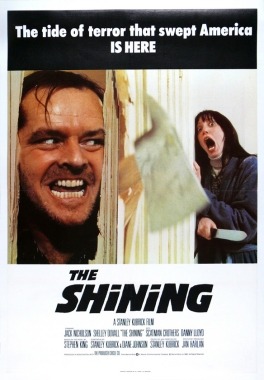

The next film is Full Metal Jacket, based in the Vietnam War. The film starts out with soldiers getting their heads shaved, representing the first step in their dehumanization at the hands of the U.S Military. Vietnam is not considered a just war and is an obvious extension of the genocidal characteristics America was born into. America is still doing the same thing that The Shining represents; going into a place full of brown skinned people and wreaking havoc for their own benefit and seemingly justified by racial bias. Vietnam is truly the beginning of a modern genocide, justified by politics, fear, money, and propaganda. This film came out in 1987, 12 years after Vietnam ended, but interestingly enough 3 years before another example of this American Imperialism; The Gulf War. Full Metal Jacket makes us look at something inhumane that just recently happened and yet most people remember the drill Sergeant yelling hilarious obscenities at the soldiers, many thinking the second half of the film as inferior to the first. As horrific as the dehumanization process of bootcamp is, it’s easier to watch than the reality that happened in Vietnam. In the film’s major battle sequence, we see multiple solders die, wasting hundreds of rounds only to find one young girl to be their target. This is the reality of Vietnam. Note the poster’s reference to Joker’s helmet, BORN TO KILL, relating to both the birth of America and the eagle behind Ullman’s head, turning him into a literal figurehead of this inherited American violence.
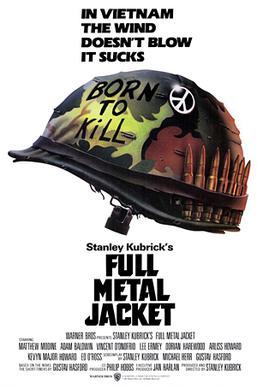
Eyes Wide Shut continues this theme from the perspective of someone living their adult life in post Vietnam society. The modern genocide has turned war into a commodity and has shown the darkest side of capitalism. Bill probably was too young to go to Vietnam but would be a first generation adult starting a family post Vietnam (meaning he was old enough to experience Vietnam as a child but not old enough to go).
Coincidentally enough, when EWS was released in 1999 the US were only a few years away from yet another unjust conflict in Iraq based on lies with huge non-compete contracts handed out to companies that the G.W. Bush administration had personal and financial connections with. It’s also interesting to note that although this couldn’t have been intended by Kubrick, the themes of generational violence being passed down through the generations connects to George Bush starting an Iraq war in the 90s while just over a decade later his son would do that same. Kubrick saw humanity in such a deep way, the good and bad, that he’s almost seen the future through his exploration of complex themes. Sadly though I don’t believe he was psychic, but purely able to to see the reality of cycles we humans perpetuate throughout time.
Eyes Wide Shut is about modern society’s classist structures and how someone like Bill Harford could be so oblivious to the dangers that surround his lovely life and how easily that can be taken away by his own inability to see himself and the various social constructs he participates in. He is blind to the world, happy as clam to live an upperclass Manhattanite lifestyle. This is inherently connected to the more overt violent themes in the previous two films. There is a cultural genocide perpetuated by the richest people who use others like pieces on a chessboard; built off of the original sin of America’s treatment of the Natives and continued through our unjust wars of today, finally providing the power structure for a few people to wield over the rest. Money in Eyes Wide Shut is equivalent to the axe in The Shining, the rifles in Full Metal Jacket. The first line in Eyes Wide Shut is, “Honey have you seen my wallet?”. This is no accident, it’s a seemingly insignificant line of dialog that immediately begins to beg you to pay attention to this theme.
- From The Shining: ULLMAN: We had four presidents who stayed here, lots of movie stars. WENDY: Royalty? ULLMAN: All the best people.
See my post on “All the best people”
17 notes
·
View notes
Text
I’m seeing a lot of reactions to Destielgate, like, from outside of fannish spaces and it’s kind of... disheartening how quick people are to write off shippers.
Like I know -- what frivolous, silly people we are! Constructing elaborate online communities about which fictional characters we want to see together! Go outside and talk to some real people, amirite?
Except no. There’s nothing wrong with that, and even so, it’s always been more than that.
I want to preface this by saying, I stopped watching the show a few years back. I was never even interested in it when it first came out, and it was actually the shippers that eventually made me take an interest; when I’d stopped watching for years, it was this year -- the day they had Castiel finally confess his love for Dean -- that I finally thought that maybe, just maybe, the show might be worth picking up again. So for this casual viewer, at least, the promise of this rep was enough to bring me back in. So that's something.
I see non-fannish people throwing scorn at folks for desperately hunting for breadcrumbs, for validation, about Destiel. I see them asking, exasperated, that if we’re so desperate for queer rep, why don’t we go look for it where it actually is, in LGBTQ books? And that’s all well and good (we absolutely need to boost those stories and voices), but it’s not enough to just be content with getting a tiny section in a bookstore. We want to see ourselves in the mainstream, too. We want an actual mainstream show, one with a huge following, to take the leap and show us actual queer characters in lead roles.
And Destiel could have been that.
There have been people shipping it since day one, writing fanfic, drawing art, crafting truly incredible meta, and it was never just about shipping, it was about seeing a queer love story unfold in the unlikeliest of places, a queer love story that involved so much pain and hardship and, ultimately, triumph, and seeing it all proudly displayed in a TV show that, for all intents and purposes, is monumental in its popularity.
So I know, yeah, if we’re so disappointed with mainstream stuff failing us on the rep count, we can just go and read stories written by actual LGBTQ people. I know that. We all do. And I hope someday those stories will attain the same popularity as things like this, and we can only get there by putting our wallets where our mouths are -- but it will be a long, long time before those stories reach the same vast audiences that shows like this do. In the meantime, are we really going to sit back and be content with being a shelf hidden away in the back of a bookstore?
I’m not asking non-fannish people to be shippers. I’m not even telling them to enable shippers, or to agree with (what they see as) ‘conspiracy theories’. I just wish they would stop seeing shippers as stupid, frivolous people getting their jollies by writing trashy gay romance about ‘two straight characters’. I’m tired of them seeing things like Destielgate and writing it off as ‘shippers throwing a tantrum’ because our ship didn’t become canon (except, it did. #yoati bitches)
Because it’s not about that (and even if it were, what the hell is wrong with that??), it’s about finally seeing meaningful narratives involving people like us, people like our friends, on major TV shows. It’s about no longer having to content ourselves with being a ‘niche interest’, and actually seeing ourselves represented in spaces that have been dominated for a literal century (longer if you're not just counting TV/movies) by only one type of romance.
#bones rambles#i just needed to get this out#i know shipping is for a select group of people#but i'm tired of trying to discuss actual queer rep in fiction and having OTHER QUEER PEOPLE write it off because it's about shipping
2 notes
·
View notes
Text
The Untamed Review!
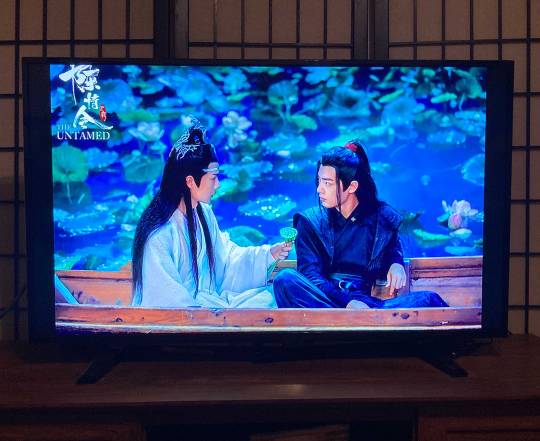
The Untamed (陈情令)
Written by: Yang Xia, Deng Yaoyu, Ma Jing and Guo Guangyun
Directed by: Zheng Weiwen and Chen Jialin
Based on Mo Dao Zu Shi (魔道祖师) by Mo Xiang Tong Xiu
Tencent Penguin Pictures and New Style Media, 2019
Chinese fantasy (Xianxia) TV series
Rating: 3.5/5 Waves

Summary: Wei Wuxian is a prodigy cultivator known for his charm and recklessness. Lan Wanji is as powerful as he is strict. Wei Wuxian has never seen a rule he wouldn’t break and Lan Wanji had never broken a rule in his life. Their unlikely friendship is tested by war, loss, and nefarious schemes. Wei Wuxian awakes in a future he never expected to see and is tasked with unraveling a mystery that could upend the entire cultivation world.
This post does NOT contain spoilers for The Untamed.
Content Warnings for The Untamed: Violence, Torture, Death, Sexual Assault/Rape, Self-harm, Suicide, Incest
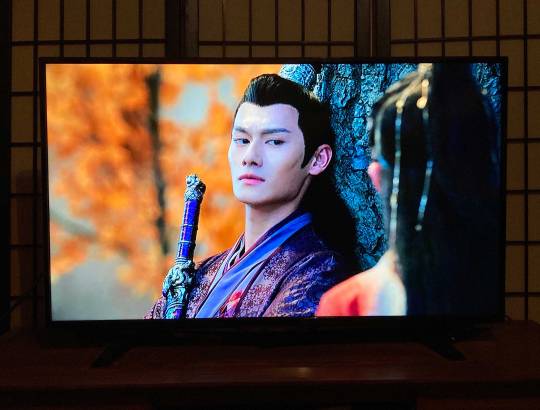
The Untamed is a fantasy TV series based on the novel Mo Dao Zu Shi by Mo Xiang Tong Xiu. I’ve never read the book (though I intend to after seeing this show) so I can’t speak to how faithfully the original story was retold. Fortunately for fantasy fans like myself, the context of the original is unnecessary to fall in love with this show. The Untamed came highly recommended from friends and it is the first Chinese fantasy series I have ever seen. The show is in Mandarin, but for those of us who don’t speak that, Netflix has English, Vietnamese, and Spanish subtitle options. They were easy to follow and my friend who watched with me (and speaks Mandarin) assured me that the subtitles were acceptably accurate.
I loved so much about this show from the casting and costumes to complex characters and the devastating emotional impact. Every few episodes I had to stop and admire the cast and the character design in this show. The Untamed has a cast of more than 30 recurring memorable characters and every single actor slipped into their role perfectly. Between the talent of the actors and the attention to detail in their costumes, each character came across exactly as the narrative intended. There were clues and foreshadowing that an attentive viewer could follow by simply being able to identify a character from the hem of their robes or the pattern of their headpiece. The effort and skill that went into these characters make the show both beautiful to look at and exciting to follow.
Aside from the physical appearance of the characters, they were also spectacularly written. Nearly every single character has complex and realistic motivations that make even the side characters feel like real people. You can see why each choice was made, even though some will clearly have dire consequences. Even the villains of this story have so much depth that I’d catch myself saying, “Oh I see why you did that! It’s horrifyingly evil and irredeemable, but I get it.” And because of how well written these characters are, the emotional impact when we lose one to battle or betrayal is devastating.

I promised this review was spoiler-free so I will not say who doesn’t make it, but as a consumer of mostly American fantasy, this show surprised me. I’ve been told that in this genre (Xianxia), do not assume that characters are safe and plot armor isn’t always a thing. So fair warning for anyone who is interested in this show: a lot of characters die. The deaths make sense and while some are clearly for shock value, all have the appropriate emotional and political consequences in the story. But since all of the characters are both visually and narratively compelling, it’s going to hurt.
Another aspect of this show I enjoyed was the underlying LGBT+ themes. The novel that the show is based off of has explicitly queer characters and though that is not the case in The Untamed, the spirit of the source material is still very present in the show. As a member of the LGBT+ community, the subtext was abundantly clear to me. By excluding the physical intimacy of characters who were queer in the novel, they relied on the emotional intimacy to carry the story. This felt much more impactful than other media I’ve seen that relied solely on obvious romantic cues like kissing and saying “I love you” without creating depth in the relationships. In fact, from my perspective, nearly every character in the show was queer-coded in one way or another which was a very refreshing experience. On the other hand, I don’t want to gloss over the fact that the show did try to straight-wash these characters. The Untamed aired in China in 2019. Diversity and representation are so important and it is frustrating to see something mainstream come so close to being good representation while refusing to commit to it. Overall, they could have done better, but it was still pretty gay for not being gay.

Some reasons this show received only 3.5 waves in spite of me loving it include the narrative timeline and pacing, the special effects and editing, and the general lack of women characters. The Untamed made an interesting framing choice in that episodes 3-33 consist of one continuous flashback. Personally, I found it confusing and unnecessary. If 30 of 50 episodes are going to be flashbacks, why not simply tell the story in order? While this framing choice does give the audience some fun clues and increase the intrigue, by episode 34 I forgot everything that happened in the first two episodes. It also left me wondering why they would introduce the main plot and then immediately change course. While the story arcs in the flashback do cause the conflicts happening in the present, both time periods have their own distinct plot. In the flashback there is a war and its fallout that are explored. In the present timeline, the story is essentially a murder mystery. It felt like I was watching two separate shows.
A related problem I had with the show was the pacing. I loved seeing all of these characters on screen for fifty 40 minute episodes, but the source material is a single novel. This story could have been told in 30-40 episodes easily. This left some episodes lacking depth and feeling pointless, while also inexplicably leaving some subplots completely unexplored (the Yin Iron shard with the florist in episode 8 for example). This coupled with distracting editing choices-- like ending an episode mid-sentence or abruptly cutting between two unrelated scenes-- made bingeing this show difficult. Fortunately, by the time I started noticing this stuff I was already in too deep with the characters to stop. The special effects for some of the monsters also left something to be desired. While not a deal breaker for me, the poor special effects were made especially obvious by the exceptional costumes and set pieces.
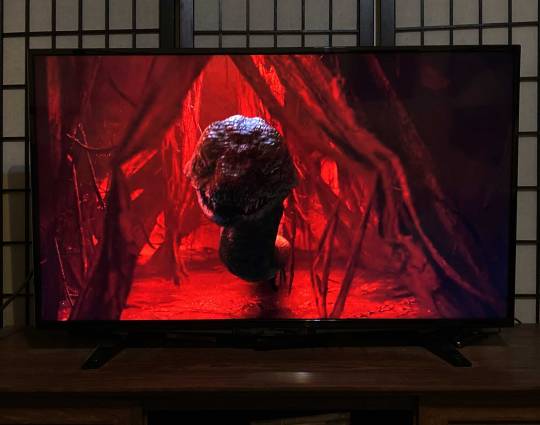
Another thing that decreased my rating of this show was the lack of women characters. In a cast this large, I was very disappointed in the number of women. While there doesn’t seem to be any explicit sexism in the show, the lack of women characters does seem to imply that women are not welcome in certain circles. In this fantasy setting there was so much room to have a balance of different genders, but the vast majority of the main characters (and most of the side characters) were all men. To be fair though, the women that were present got the same level of dedication into making their characters compelling and complex. For the purposes of representing women The Untamed is better than some media I’ve reviewed (looking at you A New Hope), but still left me wanting more.

Overall, I had a fantastic time watching this show. Is it a masterpiece in technical filmmaking? No. Did it have some of the best characters I’ve seen in a long time? Definitely. I highly recommend this show to anyone who loves deep characters, pretty costumes, or being absolutely wrecked emotionally.
~TideMod
3 notes
·
View notes
Text
What ia the pest pc for gaming
Best 20 Gaming Blogs You Ought to Be Following
On the internet Gambling Sites covers the whole industry of gaming more than the Web. A single of the significant challenges of spending too much time in front of computers, tablets, or even smartphones is that you get exposed to the eye-damaging effects of high energy blue light. This can lead to the formation of cataracts, the development of macular degeneration, and even permanent harm to the retina. With the Gunnar Optiks Intercept Computer system Gaming Glasses , you can proficiently block as significantly as 65 % of this damaging light though also defending you against UV rays. The Intercept is specially made for quite active pc gamers, permitting them to sleep greater as this gaming glasses can help decrease eye strain.
Under you will find more than 20 amazing gaming WordPress themes for many purposes to come to be portion of the speedy moving gaming industry. NVIDIA GAMESTREAM technology operates exactly like desktop GAMESTREAM, and is compatible with GeForce GTX 800M, GTX 700M, and pick GTX 600M GPUs installed in some of today's best gaming notebooks.
Reasonably priced with a extremely vast community of developers, Unity offers the best worth for an extremely advanced game development engine. With fantastic editing tools very easily extended through plug-ins, this platform supports a surprising massive variety of asset formats. It has the longest track record of all gaming platforms with mobile games. The free of charge license is enough to cover the majority of capabilities of the gaming engine with a beginner possessing little to no use of the features of the pro version. The paid version nonetheless, is also reasonably priced as well. The good quality of outcomes accomplished from Unity is undeniably impressive with a single of the most well-liked game of all times obtaining been developed on it: the Get in touch with of Duty.
Essential GAMING Smartphone Apps
Comics Gaming Magazine is an on the internet gaming community magazine that publishes articles and editorials on online gaming. The site also evaluations the most current games and sells gaming merchandise. Subscribe to their magazines to get the most up-to-date info on leading games. Azreal Llywen or Azzy for short is a particular person of contradictions getting brainy and a total idiot at the exact same time. She is a geek by heart usually amazed at science but despairs at the sight of math. That is why her areas of knowledge in gaming are puzzle solving, fighting and flat kind games.
Could 17, 2016 • Since its founding only six years ago, Green Man Gaming has develop into one of the best known digital distributor of pc games. The exposure came from supplying titles at very reasonable costs. At initial this was accomplished through a special digital trade-back service in which Pc games could be resold at a discounted cost, but in extra recent years the on the net retailer has also gotten into the business enterprise of promoting genuine keys to digitally distributed Pc games - at times obtained contractually with the original publisher, and in some cases with keys sourced from third-parties, as was the higher-profile case final year with The Witcher III.
Android gamers represent 78% of the worldwide mobile gaming industry and can be worth eight times additional than iOS players in the nation. The Gimars Memory Foam Set actually comes with two pads: one particular for each and every wrist. Due to the fact gamers typically use both keyboard and mouse when gaming, we advise this set. Sssniperwolf is 1 of the world's largest female gaming influencers, and definitely one to watch out for in 2018. Her channel is complete of good video game content material, which includes her Contact of Duty videos, which are particularly popular amongst viewers.
Ask a Game Dev is a Tumblr blog dedicated to hosting a wealth of answers to any questions that arise about the planet of developing video games. The blog has been running for quite a few years and has amassed a large archive in that time, but the creator still answers new questions on an ongoing basis. Gaining the sort of insight that only an sector insider can provide is a excellent tool for these aspiring to break into game improvement, and the concerns answered can be especially topical through massive gaming events such as E3.
You have played thousands of diverse board games, yes that is appropriate not hundreds, but thousands. You are a member of many gaming groups, and you have come to realise that various groups have diverse personalities and special dynamics. You comprehend what style of games you appreciate and precise mechanics that you do and don't like in a game. You do not actively preach or tell individuals about board games, but when asked you are an ambassador for the genre and with your vast know-how you can often add thoughtful discussion and predictions with regards to games you are yet to play. Your collection is the perfect variety of games that you like. It is not straightforward for a new game to make it into your collection, and you have a defined a rigorous trial of fire that any game need to meet to make it effectively into your collection.
How do corporations fight back whilst keeping their customers happy? We chatted with Danièle Thillmann, Senior VP of Fraud and Payments at Green Man Gaming. Danièle reveals how companies can confront the unique challenges of a digital vertical. Armed with years of experience in the gaming planet, Danièle shares how gaming businesses make a tricky and essential decision: which fraud prevention option to use.
With the cost of video gaming currently much larger than mobile gaming in most aspects, from game value to hardware, the mobile gaming sector looks stronger than ever. Not only do most folks currently own a gaming-capable smartphone already, but mobile applications are commonly compatible on most devices. Combine this compatibility with the large range of mobile games on present and you are certain to obtain a game for you on any device, regardless of make or model.
This weblog aims to create a actual neighborhood that cares about topics like technology, gaming and gadgets, providing news and reviews. Furthermore, it permits the readers to interact with the rest of neighborhood by means of comments and polls, but also enabling them to write guest posts. Green Man Gaming's publishing arm functions with developers to help publish and market their personal games, supporting them every single step of the way. Their vibrant on the internet neighborhood also connects gamers and rewards them for in-game activity. This gameplay data permits them to additional boost the overall gaming knowledge.
Why we like it: This is a perfect gaming podcast if you want to understand how the game sector actually works. The episodes cover topics like What is incorrect with user critiques?”, What does it expense to make a video game?”, Why distribution is cool”, How to get your game published”, and other folks. This is most likely the most helpful way to make income online within any business and surely with your gaming blog as nicely.
So, you've got the game created, persons are taking notice, and members of the technologies and gaming press want to know far more. This is where presskit() comes in. Most of the news and testimonials have been categorized in accordance with their gaming consoles on a reader-friendly interface. And when you happen to be tired of reading the news and critiques, head more than to the Message Board for a laid-back chat with members of the Siliconera neighborhood.
Meet NVIDIA SHIELD portable —the ultimate gaming and entertainment portable. Unleash your favored Android and Pc games, motion pictures, music, and more. Take on the newest console-excellent Android games with beautiful HD 720p graphics, booming stereo sound, and the precise, familiar overall performance of a console-grade game controller. Stream your Pc games more than Wi-Fi or Ethernet to play around the property, on your big screen HDTV, or even outdoors your house. Get lost in the hottest movies, music, or e-books with a spectacular 5” retinal-high-quality multi-touch display and custom tuned bass reflex audio. And enjoy the most current Android KitKat OS—with instant access to thousands of good games and apps. All powered by check here the incredibly fast NVIDIA Tegra four mobile processor, and ready to go whenever you are.
Whilst a lot of of smartphone gaming apps pale in comparison to those games that are developed particularly for handheld gaming consoles like the PlayStation Transportable, the Nintendo DS3, and other folks, they can nevertheless, supply you with nearly the very same level of gaming encounter. This can be further enhanced if you use the Power A MOGA Pro Mobile Gaming Method that characteristics an Xbox 1-inspired game controller that you can use to attach your Android-based smartphone or tablet. It comes complete with complete-sized grips, dual analog sticks, D-pads, illuminated action buttons, triggers, and even shoulder buttons to mimic the gaming expertise of a actual gaming console. Make positive you also verify the rest of our Xbox a single accessories for much more good products like this.
1 note
·
View note
Text
Katabasis Patterns in Pirates of the Caribbean: At World’s End
Or, in which I make use of my official Classics minor (and my unofficial film nerd minor) while ignoring my French major altogether.
Howdy, everyone, and welcome to this week’s episode of Extremely On My Bullshit! Today we’re going to talk at length about how the trip to Davy Jones’ Locker in Pirates of the Caribbean: At World’s End borrows elements from various classical narratives containing a katabasis, or a trip to the Underworld. This will be a slightly Tumblr-ified version of an actual paper I wrote for my Classical Antiquity On Screen final.
Shoutout to this post by @charlesdances, which allowed me to infodump about Hades/Persephone parallels in Barbossa and Elizabeth’s relationship across the trilogy, and to @aye-tortuga for requesting this longer post, which I teased at the end of the aforementioned meta.
Right then, let’s get started! Under a cut to spare your dashes from long post made longer still by screencaps and works cited (yep, it’s that kind of meta). For the purposes of this meta, only the first three Pirates films will be considered canon as the later sequels contradicted elements of the established lore.
I touched on this in the first paragraph, but I’ll begin by defining two words which will appear throughout this meta: katabasis and anabasis. Katabasis and anabasis are Ancient Greek terms which refer to “that narrative . . . that portrays the hero’s descent into, and ascent from, the underworld—the journey to hell” (Holtsmark 25). (If you want to get etymological about it, kata is down, ana is up, and baino comes from the verb meaning “to go [on foot].”)
This katabasis narrative takes place in the first act of At World’s End. If you’ll recall, Dead Man’s Chest ended with Elizabeth chaining Jack to the Black Pearl’s mast: she knew the Kraken was only interested in Jack, so she sacrificed him to give herself and the others a chance to escape. However, at the very end of the film, Elizabeth and the crew of the Pearl pledge to retrieve Jack from his resting place in Davy Jones’ Locker (the Underworld), and Tia Dalma offers both herself and Barbossa as guides to those “weird and haunted shores.”
So, after the cinematic fucking masterpiece that is the opening “Hoist the Colours” sequence (I also wrote a paper on that lol), we find ourselves in Singapore, where Elizabeth, Barbossa, and co. meet with the pirate lord Sao Feng in hopes of obtaining a map to the Locker. The Singapore segment opens with Elizabeth piloting a lone craft along a murky river, evoking images of Charon with his ferryman’s pole:
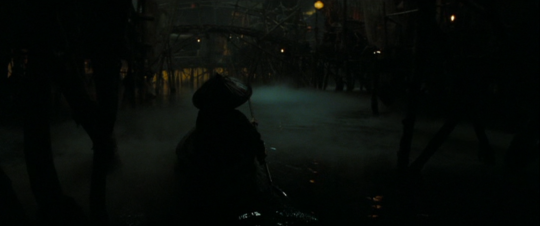

As she poles the boat along, she sings a pirate tune with decidedly death-centric lyrics, tuning us in to the symbolism and themes at play: “Some men have died and some are alive / Others sail on the sea / With the keys to the cage and the Devil to pay / We lay to Fiddler’s Green.* / The bell has been raised from its watery grave / Hear its sepulchral tone . . .” (*A form of afterlife from maritime folklore)
At the end of this scene, we see something odd: Tia Dalma dressed as a blind organ grinder.

Plot-wise, this serves to divert the colonial soldiers’ attention from the pirates’ activity, but metaphorically, here she represents the blind seer Tiresias, whom Odysseus encounters when he first enters the realm of Hades (Odyssey 11.187-149).
When the pirates meet Sao Feng, the imagery starts to mix a little. The filmmakers present Sao Feng in a somewhat Hades-esque (Hadean?) manner (steam, flames, and warm tones, with a skylight to imply subterranean depths):
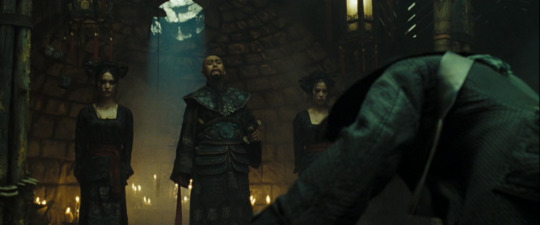
However, while he is a powerful figure, he does not keep the Underworld itself (that duty falls to Jones); he merely keeps the knowledge of its entrance. Barbossa attempts to gain this knowledge by presenting Sao Feng with a silver coin: a reminder of his duty as Pirate Lord as well as another Charon parallel. Barbossa’s tactic does not work, but like in the previous scene, the imagery prepares viewers for the descent to come.
After getting Sao Feng’s navigational charts another way, the pirates’ journey to the underworld continues in earnest. When Will expresses doubt about their path, Barbossa nearly quotes the Aeneid outright: “Trust me, young Master Turner: it’s not gettin’ to the Land of the Dead that’s the problem; it’s gettin’ back.” This echoes the Cumaean Sibyl’s famous words to Aeneas: “Easy is the descent to [the Underworld]: night and day the door of gloomy Dis stands open; but to recall one’s steps and pass out to the upper air, this is the task, this the toil!” (Aeneid 6.126-129, tr. H.R. Fairclough). Aeneas, guided by the Sibyl, passes through the mouth of a cave as part of his descent (“A deep cave there was, yawning wide and vast, of jagged rock” (Aeneid 6.237-238, cf. 6.262-263, tr. Fairclough)); likewise the pirates, guided by Barbossa and the charts, pass through a cave as they travel into stranger climes:
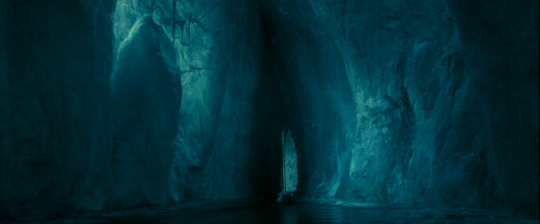
(Buuuut to be fair, this one is possibly just incidental or else more of a reference to Gustave Doré’s art for Rime of the Ancient Mariner rather than a reference to any specific classical text. Doré’s artwork is used elsewhere in PotC, so it’s prolly just aesthetic. Also caves are cool and the ultimate symbolic doorway.)
Next they come to a distant, shadowy realm with a misty sky and a sea tranquil enough to reflect starlight:
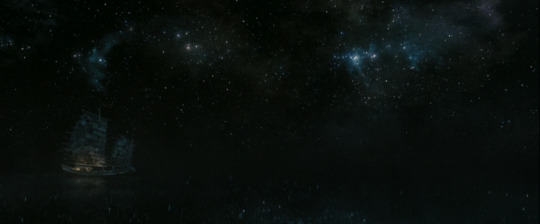

Again, this could also be incidental (and/or just a really cool homage to the sailing-to-the-moon scene in The Adventures of Baron Munchausen (1988)), but it does have a classical counterpart: “The ship took us to the deep, outermost Ocean / And the land of the Cimmerians, a people / Shrouded in mist. The sun never shines there [...] Nor bathes them in the glow of its last golden rays; / Their wretched sky is always racked with night’s gloom” (Odyssey 11.14-19).
Both of these qualities—the cave and the darkness—fit Holtsmark’s observations on katabatic patterns: “The entryway to the other world is often conceived as lying in caves or grottoes or other openings in the earth’s crust into the nether regions, such as chasms or clefts. . . . The lower world is generally dank and dark, and the journey usually takes place at dusk or during the night” (Holtsmark 25).
At last, the pirates’ ship goes over the edge of an enormous waterfall and the screen fades to black. Voices from the original Pirates of the Caribbean theme park ride echo over the dark screen, ending with the ominous phrase “Dead men tell no tales.” However, we shall soon see this proved very wrong, for the pirates encounter several souls with tales to tell. As for these nameless voices, they may represent multitudes of “bloodless shades” (Metamorphoses 10.42) left to languish in other parts of the Locker/Underworld.
At this point, the narrative cuts from the pirate band to Jack in Davy Jones’ Locker. Jack warrants special punishment from Jones for disobeying the rules of a bargain they’d once struck (*yells forever about the good parts of The Price of Freedom and the crimes wrought by the DMTNT retcons*). Jack’s own special hell, recalling the punishments of Tantalus and Sisyphus (Odyssey 11.611-629), does include his beloved Black Pearl (explicitly stated, by Jack himself, to be a symbol of personal freedom), but now it rests completely beached upon an endless, windless salt flat. Jack is utterly alone in this wasteland, save for a crew of his own imaginary doppelgängers.
(I’m gonna be real with y’all: I don’t care for this scene at all and it brings the narrative to a screeching halt, so let’s just take a moment to angstily reflect on how profoundly this affects Jack-the-character’s psyche/mental state for the rest of the film and move on to better things. God bless RPers and fic writers who deal with this scene and its effects in a deliciously Watsonian way.)
Tia Dalma/Calypso’s crabs eventually come to bear both captain and ship back to the sea. This could be seen as classical-type divine aid/favoritism (a semi-literal deus ex machina) or as awkward, oh-no-what-do-we-do-now screenwriting, take your pick. The crabs take Jack and the Pearl directly to the rest of the pirates, who have washed up on the Locker’s desolate shore. In a twist on the classical formula, Jack initially thinks his rescuers the dead ones as they recount their past experiences. Additionally, Jack represents a sort of Eurydice figure as the dead-in-need-of-rescuing, while his Orpheus, Elizabeth, is ironically the one who “killed” him in the first place. All the pirates (Jack included) finally set sail in the freed Black Pearl and attempt to escape this Underworld: the anabasis has begun.
On their way out, when the sky grows dark, the crew encounter scores upon scores of shades floating aimlessly upon the sea:
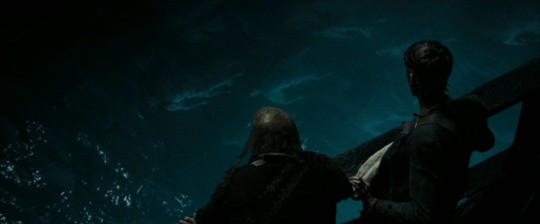
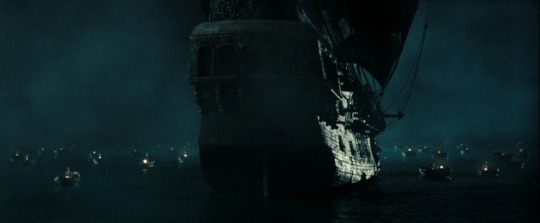
This parallels Odysseus’ experience (“Then out of Erebus / The souls of the dead gathered / . . . They drifted up to the pit from all sides / With an eerie cry, and pale fear seized me” (Odyssey 11.34-35, 40-41)) as well as that of Aeneas (“Hither rushed all the [ghostly] throng, streaming to the banks . . . They stood, pleading to be the first ferried across, and stretched out hands in yearning for the farther shore” (Aeneid 6.305, 313-314)). Tia Dalma reveals that long ago, Calypso had charged Davy Jones “to ferry those who died at sea to the Other Side,” but he has since abandoned his duty, hence his current eldritch appearance. This explicitly posits Jones as a failed psychopomp who has now left these souls stranded like the unburied men of the Odyssey and Aeneid.
The crew leave these shades in peace until Elizabeth spots a familiar face: her father.
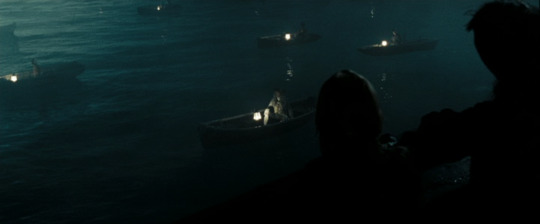

At this point I must ask you to rewatch this scene so you can fully appreciate the parallels without me including a lengthy transcript in this already long post.
This scene comes directly from classical literature, as both Odysseus and Aeneas encountered dead parents in the Underworld. Odysseus saw his mother: “. . . At once / She knew me, and her words reached me on wings: / ‘My child, how did you come to the undergloom / While you are still alive? It is hard for the living / To reach these shores. There are many rivers to cross, / Great bodies of water, nightmarish streams, / And Ocean itself, which cannot be crossed on foot / But only in a well-built ship’” (Odyssey 11.151-158). Like Elizabeth, Odysseus had no prior knowledge of his mother’s passing (11.170). His mother warned him of the dangerous situation which had sprung up during his absence, just as Weatherby Swann warned the pirates of the dangers of Davy Jones’ Heart. Aeneas likewise encountered the spirit of his father, Anchises: “‘Have you come at last[?] . . . Over what lands, what wide seas have you journeyed to my welcome! What dangers have beset you, my son!’” (Aeneid 6.687-693). Anchises, too, offers some advice for the future, for he “tells of the wars that the hero next must wage . . . [and] how to face or flee each peril” (6.890-892). Having Elizabeth be the one to encounter a dead parent in the Underworld confirms her as the series’ protagonist, in case that wasn’t patently obvious from the rest of the trilogy (and the failure of Pirates 4 and 5). Weatherby Swann’s warning also serves to remind the audience of the stakes.
Finally, the pirates make their way out of the Locker. While the remainder of their journey takes more inspiration from Rime of the Ancient Mariner and Western European folklore than classical literature, the latter’s influence on the film remains quite clear. When the pirates return to the land of the living, it is daybreak:

(*Lawrence of Arabia theme, but on a cello*)
So, too, does Odysseus emerge from the Underworld into a new dawn: “Our ship left the River Ocean / And came to the swell of the open sea / . . . Where Dawn has her dancing grounds / And the Sun his risings” (Odyssey 12.1-5). The pirates thus complete their katabasis/anabasis, and with rather more luck than Orpheus.
In review: The pirates begin their katabasis in Singapore, which boasts a plethora of Underworld symbolism, including a death-centric song and images of Charon, Tiresias, and Hades. They cross various waters in their descent, mirroring locations from Homer and Vergil, and Barbossa quotes the Cumaean Sibyl. Elizabeth and the pirates retrieve Jack from the Locker’s punishments in a twist on the Orpheus and Eurydice myth. Like Odysseus and Aeneas, Elizabeth sees her dead parent in the Underworld, who warns her of things to come. In the end, the pirates emerge from the Underworld into the light of dawn, signalling their return to life. By borrowing from Homer, Vergil, and Ovid, At World’s End presents an Underworld narrative which is familiar in structure and yet easily incorporated into a new mythology: “Same story, different versions.”
(Please message me if you’d like to quote/reference this post in a paper and I can give you my name + details on the official version! Plagiarism is shitty and unnecessary!)
WORKS CITED
Crispin, A.C. Pirates of the Caribbean: The Price of Freedom. Disney Editions, 2011.
Fairclough, H.R., translator. The Aeneid. 1916. By Vergil. Theoi Project, www.theoi.com/Text/VirgilAeneid6.html. Accessed 4 May 2019.
Holtsmark, Erling B. “The Katabasis Theme in Modern Cinema.” Classical Myth & Culture in Modern Cinema, edited by Martin M. Winkler, Oxford University Press, 2001, pp. 23-50.
Homer. The Odyssey. The Essential Homer, translated and edited by Stanley Lombardo, Hackett Publishing Company, 2000, pp. 241-482.
Ovid. Metamorphoses. Translated by Stanley Lombardo, Hackett Publishing Company, 2010.
Pirates of the Caribbean: At World’s End. Directed by Gore Verbinski, performances by Keira Knightley, Johnny Depp, Orlando Bloom, Bill Nighy, Chow Yun-Fat, Geoffrey Rush, Tom Hollander, Jack Davenport, and Jonathan Pryce, Walt Disney Pictures, 2007.
Pirates of the Caribbean: Dead Man’s Chest. Directed by Gore Verbinski, performances by Keira Knightley, Johnny Depp, Orlando Bloom, Bill Nighy, Tom Hollander, Jack Davenport, and Jonathan Pryce, Walt Disney Pictures, 2005.
Pirates of the Caribbean: The Curse of the Black Pearl. Directed by Gore Verbinski, performances by Keira Knightley, Johnny Depp, Orlando Bloom, Geoffrey Rush, Jack Davenport, and Jonathan Pryce, Walt Disney Pictures, 2003.
#dear god i hope this posts#pirates of the caribbean#potc#tagamemnon#meta#classics#long post#loooooooong post#katabasis#my meta#if you steal this i will physically manifest in your home and hand you the black spot
284 notes
·
View notes
Text
Text of a test monologue. Would you like to see me deliver this on camera, with no makeup, no lighting equipment, and using Notepad as a TelePrompTer? Head on over to my https://www.patreon.com/ArabellaFlynnPatreon, and for a dollar a month you too can see me waffle on in real time.
Hi, all. You may notice that I am on video now. I was going to shoot a couple of tests and apologize for the poor quality of the footage, and explain that I want to start vlogging and streaming in addition to writing, but I need some equipment to do it properly and for that I need to raise some funds... But fuck it. This is going out first instead.
As I record this, it is the fourth of July. You can probably hear the fireworks outside my window. I know I can. There are a lot of those, because we've all been inside and bored for the past four months.
I know a lot of people who have opted not to observe the holiday this year. The 4th of July is often viewed as a celebration of the American institution, which is a little bit on fire right now, with a few people determined to squirt lighter fluid all over the flames like a bored suburban dad at a barbecue. On the other hand, it's also Independence Day, and marks the end of the long, painful process by which a population broke free of distant, uncaring overlords who cared mainly about the financial dividends of their colonies, and ignored the grievances of the people until they started breaking shit. So YMMV.
I would comment on some of the details, but I don't know them. The Late Show is on hiatus, and John Oliver doesn't air until tomorrow. I, like a lot of my demographic, get most of my current events from comedians. There's a reason for that.
I actually watched a lot of news as a teenager.
Well, "watched" might be too strong a word. It's easier for me to fall asleep if there's some sort of droning noise in the background. When I was about fifteen, I discovered that, unlike the main CNN channel, which has actual shows and documentaries, CNN Headline News just runs the day's top stories over and over again in an unending 30 minute loop. Interesting enough to keep me from falling into a train of thought that will prevent me from sleeping, boring enough that I don't want to stay up and listen.
I have no memory of the desk anchors. I'm sure they were consummate professionals, but they also had no distinguishing human characteristics whatsoever. I know they were updating the loop live, because occasionally a story would be added to the list and another one would drop off the back, and occasionally one would flub the text on their prompter, but other than that there was no hint that the face at the desk was attached to a living, breathing person.
I do remember a couple of the correspondents. One was Christiane Amanpour. Her voice stood out; CNN is an American news station that was originally restricted to American cable networks, and the vast majority of the staff is from the US. Amanpour is British-Iranian, having split her childhood between Tehran, before the revolution, and London, after. They liked to send her to the bowels of Eastern Europe to report from the war-torn streets of Citygrad in Countrystan. She had already caught some criticism on her reporting of the Bosnian War, for advancing the apparently controversial opinion that genocide was bad. I didn't know that at the time; I just thought she sounded more like she told real stories than read off lists of facts.
Another was Anderson Cooper, who was not nearly such a big deal then as he is now. Cooper, a self-described adrenaline junkie, was a war correspondent at the time, with a habit of ducking only briefly for explosions before standing back up to continue his piece to camera. He wouldn't be infamous until his coverage of Hurricane Katrina years later, both for the overall stellar job he did, and also for that one time he got tired of getting non-answers from some government toad in a live interview and very professionally flipped his shit at the lady, asking if she realized how tone deaf it was to sit there thanking other politicians for doing essentially nothing while there were still bodies in the street.
I quit watching the news when I moved away to college. It wasn't necessarily that knowing was worse than not knowing, but I felt a lot of pressure to be "adult" about it at that point, and watching proper news shows made me anxious to the point where I wouldn't sleep. I outright avoided it to the point where I made it to a canceled class at 4 pm, Mountain Standard Time, on September 11, 2001, before anyone told me what was going on.
I wasn't able to put my finger on why I found the news so horrible until many years later. I can't remember what rabbit hole I'd fallen down, but I ended up sitting on YouTube watching segments of the live news coverage of the 1981 assassination attempt on President Reagan. Reagan was shot in the side and later recovered without complications, but his Press Secretary, James Brady, was struck in the head and sustained considerable neurological damage. Brady, together with his wife Sarah, later went on to be a noted advocate for gun control, but at the time was reported to have died on the scene.
I wound up watching a lot of one of the news desks -- ABC, I think. It started out like all the others, until the anchor tripped up a couple of times and referred to Press Secretary Brady as "Jim", and I realized: He knows these people. Personally. He's a member of the White House Press Corps, or a friend of the Bradys, or both. I'm watching a journalist reporting on a moment of historical significance to the American people, and a human being who has to tell the entire nation about someone's personal tragedy. His investment did not make him any less professional or informative than any of the others, but it did make his coverage feel very grounded in reality in a way that most news, then and now, does not.
The older I get, the more disquieting I find it to have a talking head behind a shiny desk read me a list of horrible things that have happened today without any apparent reaction. It makes it seem like these things are a randomized representative sample of the cruelty of the universe, rather than what they are, which is a list of things so unusually terrible they made the news. I realize that this is part of an effort to remain impartial so that the viewer can decide how they feel about events, but it's also disturbingly normative. Yes, everything is on fire, everything is always on fire, this is nothing new.
I can't say I'm any more enamored of the opposite, either, the more recent style where the news anchor's entire job is to tell you that entirety of human existence is awful and here's what you should prioritize being afraid of this week. Everything around you is on fire, the fire is racing right at you, and here's whose fault the fire is.
A lot of Americans, especially younger ones, have taken to getting their news mostly from political satire because-- well, one, because for about the past twenty years, our comedians have been better at fact-checking than our actual newsrooms. You can thank Jon Stewart for getting a bee in his bonnet over that. But also because their coverage of major issues takes neither of those paths. The Daily Show alumni write up stories like they actually live on the planet they're reporting from. You're on fire? They're on fire too! Holy shit, let's all find some water!
The conceit behind the comedy of The Daily Show and the Colbert Report and Full Frontal and Last Week Tonight and now the monologues on The Late Show is not that this is a normal amount of fire for everything to be on so it's fine, nor establishing that someone has set you on fire on purpose and here's who should be punished for it. It's bewilderment and frustration at the way we somehow keep catching on fire over and over again. Yeah, they crack jokes, because it's their job, but all the jokes are predicated on the idea that this is, above all, just very, very, inexplicably stupid. We can, and we should, be better than this. And the hosts stubbornly refuse to just give up and internalize as immutable all the reasons why we aren't.
You wouldn't know it to look at him, but Jon Stewart has accumulated "fuck you" money from his time on The Daily Show, among other things. I really hope the rest of them are doing the same. Because we need some figureheads who are able to say "fuck you" to a lot of authority figures right now without having to worry about how their family is going to survive the next month. John Oliver has HBO backing and I'm pretty sure Last Week Tonight has roughly equal budgets set aside for handling lawsuits and shoveling money at charity. Stephen Colbert has been insulting Donald Trump as hard as he possibly can since day one, and he just re-upped until 2023. Samantha Bee has her husband holding the camera to shoot her monologues out in the woods.
They've all figured out how to produce their show over the internet, so at least we have something to watch in the After Times.
I really hope the neighbors run out of fireworks soon. Aside from not wanting the neighborhood to be literally on fire at any point, one of my housemates has a dog, and the dog has epilepsy, so this has been an interesting evening. Sorry about the fireworks, sorry about the camera, sorry about the country, sorry about the state of the world. Imma go find my Xanax. G'night.
from Blogger https://ift.tt/2ZKD4d6 via IFTTT -------------------- Enjoy my writing? Consider becoming a Patron, subscribing via Kindle, or just toss a little something in my tip jar. Thanks!
2 notes
·
View notes